Chapter 1. The Guided Tour
You can’t believe how much is hidden inside this sleek, thin slab. Microphone, speaker, cameras, battery. Processor, memory, power processing. Sensors for brightness, tilt, and proximity. Twenty wireless radio antennas. A gyroscope, accelerometer, and barometer. On the iPhone X, the face-recognition system includes an infrared lamp, infrared camera, and a tiny projector.
For the rest of this book, and for the rest of your life with the iPhone, you’ll be expected to know what’s meant by, for example, “the side button” and “the Lock screen.” A guided tour, therefore, is in order.
Side Button (On/Off)
You could argue that knowing how to turn on your phone might be a useful skill.
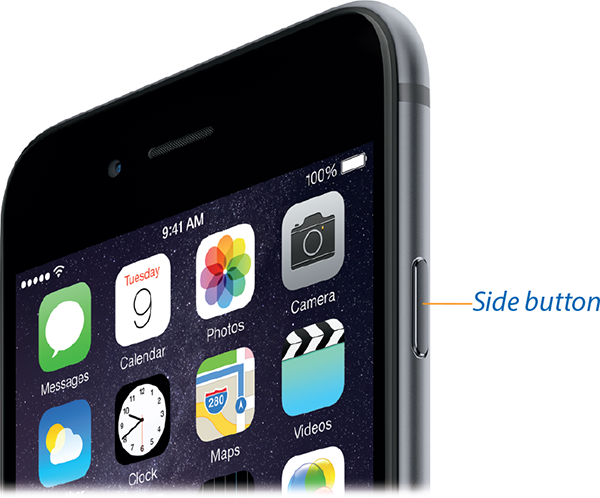
For that, you use what Apple calls the side button. (It used to be called the “sleep switch,” but it now has more responsibilities.) On the iPhone 6 and later, it’s on the right edge; on the 5s and SE, it’s on the top. (That’s right—on those phones, the side button is on the top. Keep up.)
The side button has several functions:
Sleep/wake. Tapping it once puts the iPhone into Sleep mode, ready for incoming calls but consuming very little power. Tapping it again turns on the screen so it’s ready for action.
On/off. The same switch can also turn the iPhone off completely so it consumes no power at all; incoming calls get dumped into voicemail. You might turn the iPhone off whenever you’re not going to use it for a few days.
To turn the iPhone off, hold down the side button for three seconds. The screen changes to say slide to power off.
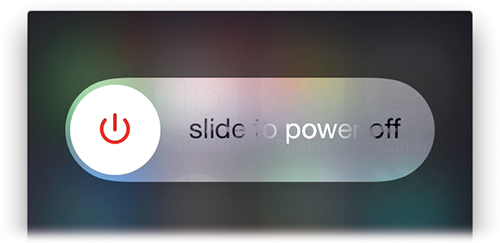
Confirm your decision by placing a fingertip on the
 and sliding to the right. The device shuts off completely.
and sliding to the right. The device shuts off completely.iPHONE X
Hold down the side button and the volume-up button that’s across from it. (Apple had to redefine this button press, since holding the side button by itself triggers Siri.)
If you change your mind about turning the iPhone off, then tap the Cancel button or do nothing; after a moment, the iPhone backs out of the slide to power off screen automatically.
To turn the iPhone back on, press the side button again for one second. The Apple logo appears as the phone boots up.
Answer call/Dump to voicemail. When a call comes in, you can tap the side button once to silence the ringing or vibrating. After four rings, the call goes to voicemail.
You can also tap it twice to dump the call to voicemail immediately. (Of course, because they didn’t hear four rings, iPhone veterans will know you’ve blown them off. Bruised egos may result. Welcome to the world of iPhone etiquette.)
In combination with other buttons, the side button is also involved in turning off fingerprint or face recognition (“Face ID (iPhone X)”) and restarting a frozen, locked-up phone (???).
iPhone X Functions
The iPhone X has no home button, so its button assignments have gotten rejiggered a bit. OK, rejiggered a lot. For example, here are some of the side button’s duties on the iPhone X:
Talk to Siri by holding in the side button (see “How to Use Siri”).
Shut down the phone by holding in the side button and the volume-up button together.
Take a screenshot by briefly pressing the side button and the volume-up button together (“Capturing the Screen”).
Pay with Apple Pay by double-clicking the side button (“Apple Pay”).
Open the Magnifier or another accessibility feature by triple-clicking the side button (???).
Sleep Mode
When you don’t touch the screen for one minute (or another interval you choose), or when you press the side button, the phone goes to sleep. The screen is dark and doesn’t respond to touch.
If you’re on a call, the call continues; if music is playing, it keeps going; if you’re recording audio, the recording proceeds. But when the phone is asleep, you don’t have to worry about accidental button pushes. You wouldn’t want to discover that your iPhone has been sending texts or taking photos from the depths of your pocket or purse. Nor would you want it to dial a random number from your back pocket, a phenomenon that’s earned the unfortunate name butt dialing.
The Lock Screen
In iOS 11, the iPhone has a state of being that’s somewhere between Sleep and on. It’s the Lock screen. You can actually get a lot done here, without ever unlocking the phone and advancing to its Home screens.
You can wake the phone by pressing the home button or the side button. Or you can just lift the phone to a vertical position.
iPHONE X
You can also wake the phone by tapping anywhere on the screen, if Tap to Wake is turned on in Settings → Accessibility → Tap to Wake.
The screen lights up, and you’re looking at the Lock screen. Here—even before you’ve entered your password or used fingerprint or face recognition—you can check the time, read your missed messages, consult your calendar, take a photo, and more.
NOTE
You can turn off the “wake when I lift you” feature. It’s in Settings → Display & Brightness; turn off Raise to Wake. Now you have to press the side or home buttons to wake the phone, as before.
This Lock screen is a complex, rich, busy universe; see Chapter 2.
Now then: If you want to proceed to the Home screen—to finish turning on the phone—then click the home button at this point.
iPHONE X
Swipe up from the bottom of the screen. It can be a very short, light, quick swipe.
The Auto–Home Screen Option
iOS 11 offers a buried but powerful option: Rest Finger to Open. (It’s in Settings → General → Accessibility → Home Button.) When you turn this on, the second click—the one to get past the Lock screen—is no longer necessary.
If your phone is asleep, then just lifting it (with your finger touching the home button) wakes it and unlocks it; you never even see the Lock screen. Or, if the phone is asleep, you can click the home button and just leave your finger on it. In each case, you save at least one home-button press.
So what if you do want to visit the Lock screen? Just raise the phone, or click the side button, without touching the home button.
iPHONE X
Unfortunately, there’s no equivalent option on the iPhone X. Once you’ve unlocked the phone (with your face, for example), you must do a quick swipe up from the bottom to proceed to the Home screen.
Home Button
Here it is: the single button on the front of every iPhone ever made (until the iPhone X). Push it to summon the Home screen, your gateway to everything the iPhone can do.
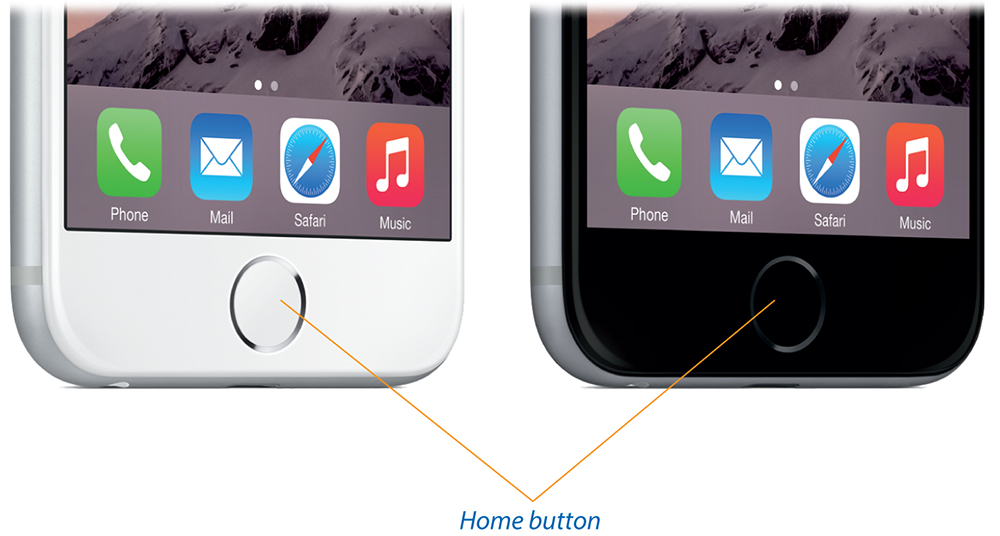
The home button is a wonderful thing. It means you can never get lost. No matter how deeply you burrow into the iPhone software, no matter how far off-track you find yourself, one push of the home button takes you back to the beginning. (On the iPhone 7 and 8, this “button” doesn’t actually move, but it feels like it does; see ???.)
iPHONE X
A swipe up from the bottom the of screen—it can be short and quick—performs the home-button function. (A black or white bar, technically called the home indicator, appears there to remind you.)
Of course, the home button is also a fingerprint scanner.
But Apple has saddled the home button with tons of other functions, too. In iPhone Land, you can press the home button one, two, or three times for different features—or even hold it down or touch it lightly for others. Here’s the rundown—with plenty of parentheticals to address the new way of doing things on the iPhone X.
Quick Press: Wake Up
Pressing the home button once wakes the phone if it’s asleep. That’s sometimes easier than finding the side button. It opens the Lock screen, where you can check notifications or the time, hop into the camera, check your calendar, and more. See Chapter 2.
iPHONE X
Press the side button to wake the phone, or just tap the screen. (That’s an option you can turn off in Settings → General → Accessibility → Tap to Wake.)
Momentary Touch: Unlock
Whenever you’re looking at the Enter Passcode screen, just resting your finger on the home button is enough to unlock the phone. (Teaching the iPhone to recognize your fingerprint is described in “Fingerprint Security (Touch ID)”.) You proceed to the Home screen. That convenience is brought to you by the Touch ID fingerprint reader that’s built into the home button.
iPHONE X
Look at the screen, so that Face ID unlocks it instead (“Face ID (iPhone X)”).
Long Press: Siri
If you hold down the home button for about three seconds, you wake up Siri, your virtual voice-controlled assistant. Details are in Chapter 5.
iPHONE X
You summon Siri by holding in the side button.
Two Quick Presses: App Switcher
If, once the phone is awake, you press the home button twice quickly, the current image fades away—to reveal the app-switcher screen, the key to the iPhone’s multitasking feature (facing page).
iPHONE X
Swipe up the screen from the bottom—but pause when your finger has traveled at least an inch up the screen. The multitasking “cards” appear after about a second.
What you see here are currently open screens of the apps you’ve used most recently (older ones are to the left). Swipe horizontally to bring more apps into view; the Home screen is always at the far right.
With a single tap on a screen’s “card,” you jump right back into an app you had open. See “The App Switcher” for more on the app switcher; for now, just remember that it gives you a way to jump directly to another app, without a layover at the Home screen first.
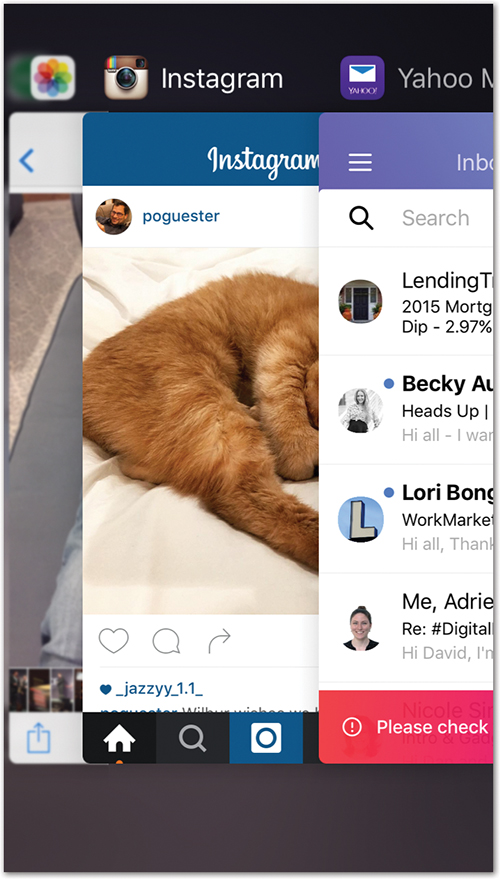
Two Touches: Reachability
Starting with the iPhone 6, the standard iPhone got bigger than previous models—and the Plus models are even biggerer. Their screens are so big, in fact, that your dinky human thumb may be too short to reach the top portion of the screen (if you’re gripping the phone near the bottom).
For that reason, Apple has built a feature called Reachability into the iPhone 6 and later models.
When you tap the home button twice (don’t click it—just touch it), the entire screen image slides halfway down the glass, so that you can reach the upper parts of it with your thumb!
iPHONE X
Tug downward at the bottom edge of the screen—for example, on the home indicator bar. (This works only if you’ve turned on Reachability in Settings → General → Accessibility.)
As soon as you touch anything on the screen—a link, a button, an empty area, anything—the screen snaps back to its usual, full-height position.
TIP
Here’s a related note: On larger iPhones, the Home screen turns 90 degrees when you rotate it. The Dock jumps to the right edge, vertically. Try it!
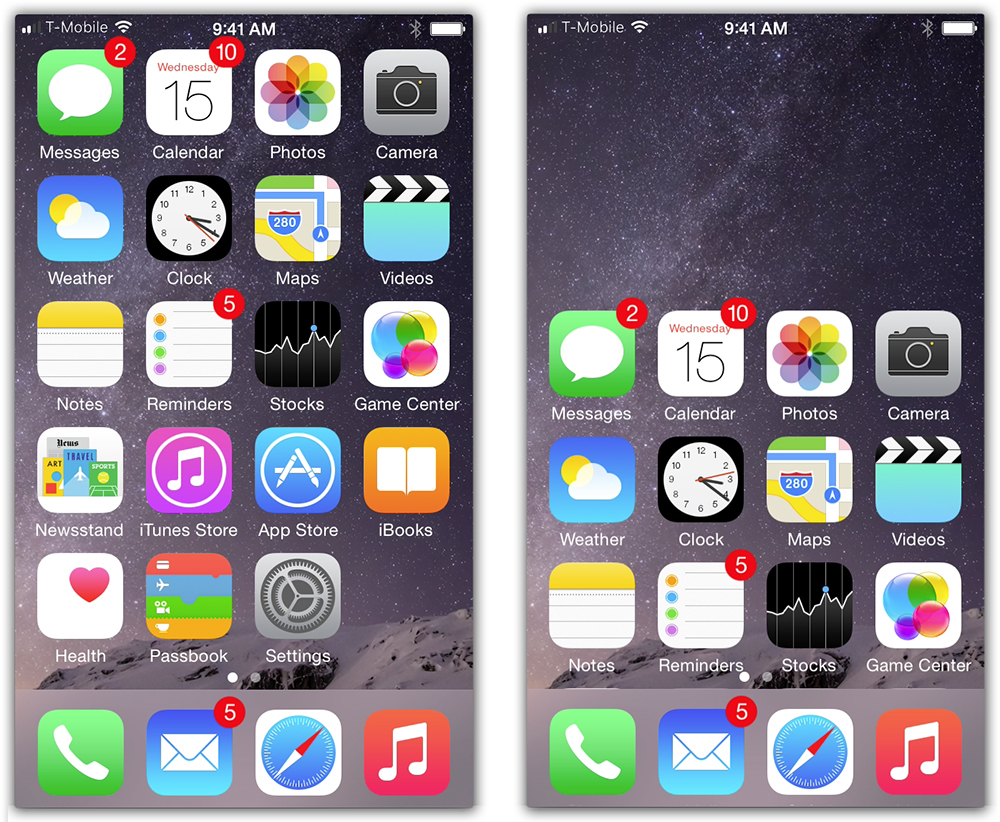
Three Presses: Magnifier, VoiceOver, Zoom…
In Settings → General → Accessibility, you can set up a triple-press of the home button to turn one of several accessibility features on or off.
iPHONE X
Triple-press the side button instead.
There’s the Magnifier (turns the iPhone into a giant electronic illuminated magnifying glass); VoiceOver (the phone speaks whatever you touch), Invert Colors (now in Classic and Smart varieties), Color Filters (screen modes to assist people with color-blindness), Reduce White Point (which makes all colors less intense), Zoom (magnifies the screen), Switch Control (accommodates external gadgets like sip-and-puff straws), and AssistiveTouch (help for people who have trouble with physical switches).
These features are all described in Chapter 7.
Silencer Switch, Volume Keys
Praise be to the gods of technology—this phone has a silencer switch! This tiny flipper, on the left edge near the top, means that no ringer or alert sound will humiliate you in a meeting, at a movie, or in church. To turn off the ringer, push the flipper toward the back of the phone.
NOTE
Even when silenced, the iPhone still makes noise in certain circumstances: when an alarm goes off; when you’re playing music; when you’re using Find My iPhone (“Find My iPhone”); when you’re using VoiceOver; or, sometimes, when a game is playing. Also, the phone still vibrates when the silencer is engaged, although you can turn that off in Settings → Sounds & Haptics.
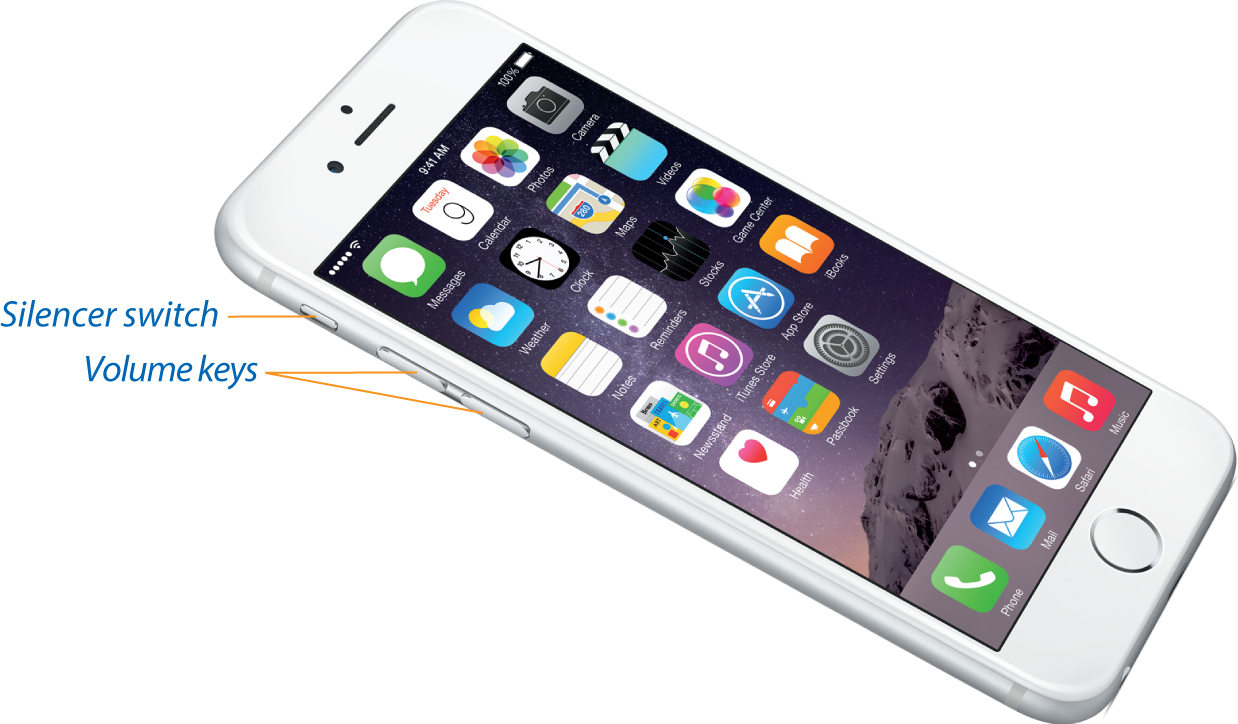
On the left edge are the volume controls. They work in five ways:
On a call, these buttons adjust the speaker or earbud volume.
When you’re listening to music, they adjust the playback volume—even when the phone is locked and dark.
When you’re taking a photo or video, either one serves as a shutter button or as a camcorder start/stop button.
At all other times, they adjust the volume of sound effects like the ringer, alarms, and Siri.
When a call comes in, they silence the ringing or vibrating.
In each case, if the screen is on, a volume graphic appears to show you where you are on the volume scale.
Screen
The touchscreen is your mouse, keyboard, dialing pad, and notepad. You might expect it to get fingerprinty and streaky.
But the modern iPhone has an oleophobic screen. That may sound like an irrational fear of yodeling, but it’s actually a coating that repels grease. A single light wipe on your clothes restores the screen to its right-out-of-the-box crystal sheen.
You can also use the screen as a mirror when the iPhone is off.
The iPhone’s Retina screen has crazy=high resolution (the number of tiny pixels per inch). It’s really, really sharp, as you’ll discover when you try to read text or make out the details of a map or a photo. The iPhone 5s and SE manage 1136 × 640 pixels; the iPhone 6/6s/7 packs in 1334 × 750; the Plus models have 1920 × 1080 (the same number of dots as a high-definition TV); and the iPhone X packs an awe-inspiring 2436 × 1125 pixels.
The front of the iPhone is a special formulation made by Corning, to Apple’s specifications—even better than the Gorilla Glass used on previous models, Apple says. It’s unbelievably resistant to scratching. (You can still shatter it if you drop it just the wrong way, though.)
If you’re nervous about protecting your iPhone, you can always get a case for it (or a “bumper”—a silicone band that wraps the edges). But if you’re worried about scratching the glass, you’re probably worrying too much. Even many Apple employees carry the iPhone in their pockets without cases.
Status-Bar Icons
Here’s a roundup of the icons you may see in the status bar at the top of the standard iPhone screen, from left to right.
iPHONE X
The iPhone X’s status bar is quite different; see “iPhone X: The Notch”.
Cell signal (
 ). As on any cellphone, the number of bars indicates the strength of your cell signal, and thus the quality of your call audio and the likelihood of losing the connection. If there are no bars, then the dreaded words “No service” appear here.
). As on any cellphone, the number of bars indicates the strength of your cell signal, and thus the quality of your call audio and the likelihood of losing the connection. If there are no bars, then the dreaded words “No service” appear here.Network name and type. These days, different parts of the country—and even your street—are blanketed by cellular Internet signals of different speeds, types, and ages. Your status bar shows you the kind of network signal it has.
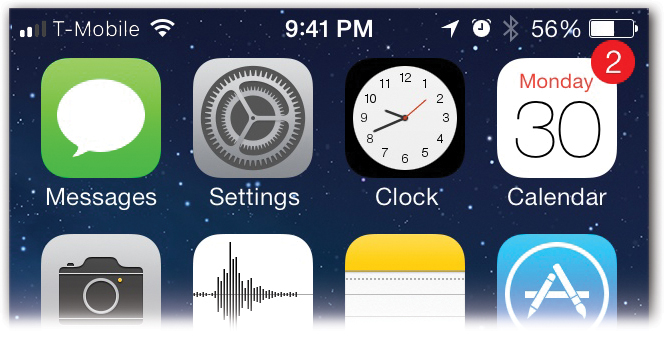
From slowest to fastest:
 or
or  means your iPhone is connected to your carrier’s slowest, oldest Internet system. You might be able to check email, but you’ll lose your mind waiting for a web page to load.
means your iPhone is connected to your carrier’s slowest, oldest Internet system. You might be able to check email, but you’ll lose your mind waiting for a web page to load.If you see
 , you’re in a city where your cell company has installed a 3G network—still slow compared to
, you’re in a city where your cell company has installed a 3G network—still slow compared to  , which offers speed in between 3G and LTE.
, which offers speed in between 3G and LTE.And if you see
 up there—well, get psyched. You have an iPhone 5 or later model, and you’re in a city with a 4G LTE cellular network. And that means very fast Internet.
up there—well, get psyched. You have an iPhone 5 or later model, and you’re in a city with a 4G LTE cellular network. And that means very fast Internet.You may also see a notation like “T-Mobile Wi-Fi” or “VZW Wi-Fi.” The iPhone 6 and later models, it turns out, can make free phone calls over a Wi-Fi network—if your cellphone carrier has permitted it, and if you’ve turned the feature in (“FaceTime Audio Calls”). It’s a great way to make calls indoors where the cell signal is terrible.
Airplane mode (
 ). If you see the airplane instead of signal and Wi-Fi bars, then the iPhone is in airplane mode (“Airplane Mode and Wi-Fi Off Mode”).
). If you see the airplane instead of signal and Wi-Fi bars, then the iPhone is in airplane mode (“Airplane Mode and Wi-Fi Off Mode”).Do Not Disturb (
 ). When the phone is in Do Not Disturb mode, nothing can make it ring, buzz, or light up except calls from the most important people. Details are in “Do Not Disturb”.
). When the phone is in Do Not Disturb mode, nothing can make it ring, buzz, or light up except calls from the most important people. Details are in “Do Not Disturb”.Wi-Fi signal (
 ). When you’re connected to a wireless Internet hotspot, this indicator appears. The more “sound waves,” the stronger the signal.
). When you’re connected to a wireless Internet hotspot, this indicator appears. The more “sound waves,” the stronger the signal.9:41 PM. When the iPhone is unlocked, a digital clock appears on the status bar.
Alarm (
 ). You’ve got an alarm set. This reminder can be valuable, especially when you intend to sleep late and don’t want an alarm to go off.
). You’ve got an alarm set. This reminder can be valuable, especially when you intend to sleep late and don’t want an alarm to go off.Bluetooth (
 ). The iPhone is connected wirelessly to a Bluetooth earpiece, speaker, or car system. (If this symbol is gray, then it means Bluetooth is turned on but not connected to any other gear—and not sucking down battery power.)
). The iPhone is connected wirelessly to a Bluetooth earpiece, speaker, or car system. (If this symbol is gray, then it means Bluetooth is turned on but not connected to any other gear—and not sucking down battery power.)TTY (
 ). You’ve turned on Teletype mode, meaning that the iPhone can communicate with a Teletype machine. (That’s a machine that lets deaf people make phone calls by typing and reading text. It hooks up to the iPhone with a special cable that Apple sells from its website.)
). You’ve turned on Teletype mode, meaning that the iPhone can communicate with a Teletype machine. (That’s a machine that lets deaf people make phone calls by typing and reading text. It hooks up to the iPhone with a special cable that Apple sells from its website.)Call forwarding (
 ). You’ve told your iPhone to auto-forward any incoming calls to a different number. This icon is awfully handy—it explains at a glance why your iPhone never seems to get calls anymore.
). You’ve told your iPhone to auto-forward any incoming calls to a different number. This icon is awfully handy—it explains at a glance why your iPhone never seems to get calls anymore.VPN (
 ). You corporate stud, you! You’ve managed to connect to your corporate network over a secure Internet connection, probably with the assistance of a systems administrator—or by consulting ???.
). You corporate stud, you! You’ve managed to connect to your corporate network over a secure Internet connection, probably with the assistance of a systems administrator—or by consulting ???.Syncing (
 ). The iPhone is currently syncing with some Internet service—iCloud, for example (Chapter 16).
). The iPhone is currently syncing with some Internet service—iCloud, for example (Chapter 16).Battery meter (
 ). When the iPhone is charging, the lightning bolt appears. Otherwise, the battery logo “empties out” from right to left to indicate how much charge remains. (You can even add a “% full” indicator to this gauge; see “Emergency SOS”.)
). When the iPhone is charging, the lightning bolt appears. Otherwise, the battery logo “empties out” from right to left to indicate how much charge remains. (You can even add a “% full” indicator to this gauge; see “Emergency SOS”.)Navigation active (
 ). You’re running a GPS navigation app, or some other app that’s tracking your location, in the background (yay, multitasking!). Why is a special icon necessary? Because those GPS apps slurp down battery power like a thirsty golden retriever. Apple wants to make sure you don’t forget you’re running it.
). You’re running a GPS navigation app, or some other app that’s tracking your location, in the background (yay, multitasking!). Why is a special icon necessary? Because those GPS apps slurp down battery power like a thirsty golden retriever. Apple wants to make sure you don’t forget you’re running it.Rotation lock (
 ). This icon reminds you that you’ve deliberately turned off the screen-rotation feature, where the screen image turns 90 degrees when you rotate the phone. Why would you want to? And how do you turn the rotation lock on or off? See ???.
). This icon reminds you that you’ve deliberately turned off the screen-rotation feature, where the screen image turns 90 degrees when you rotate the phone. Why would you want to? And how do you turn the rotation lock on or off? See ???.
From time to time, you’ll see the entire status bar change color. That’s its way of saying, “Hey, watch what you’re saying or doing, because an app in the background is observing you!” For example, the whole bar turns:
Red when you’re recording in the background—either using the Voice Memos app to record audio, or using the screen-recording feature described in “Recording Screen Video”.
Green when you’re on a phone call or FaceTime call in the background. They can still hearrrrrr youuuuu!
Blue when an app is actively tracking your location in the background. If you’re using GPS or something, well, that’s fine. But if it’s some evil app that’s tracking you, now you’ll know.
TIP
In each case, you can tap that colored status bar (or iPhone X “ear”—see below) to jump into the app responsible.
iPhone X: The Notch
Most people adore the iPhone X—enough, in fact, to pay that handsome $1,000 for it. If anyone grumbles at all, it’s about the Notch.
That’s the dark area at the top center that contains the front-facing camera, the earpiece, and the phone’s Face ID sensors (“Face ID (iPhone X)”). Apple decided that, to keep the phone as small as possible, this Notch would interrupt the standard status bar, splitting it into two “ears.”
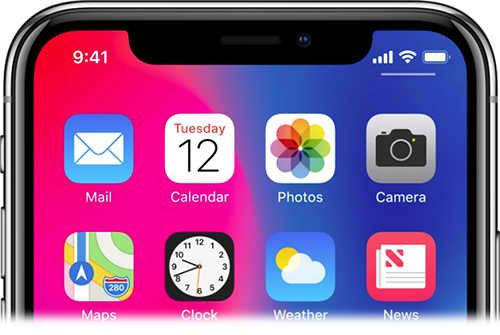
You can’t see the Notch when the status bar is black—on a black Home screen, for example. You don’t see it when you’re looking at photos or videos, either, unless you zoom into them.
You do see the Notch when the status bar is white or another color, and it’s also noticeable when you’re using an app that hasn’t been updated for the iPhone X. Sometimes those apps try to display information right where the Notch sits!
In any case, on those ears, there’s very little room for the usual array of status icons. The left ear shows the time and, sometimes, the location services logo (![]() ); and the right ear shows icons for your cellular bars, Wi-Fi strength, and battery level. (Only the left ear turns red, green, or blue to provide privacy warnings from background apps, as described already.)
); and the right ear shows icons for your cellular bars, Wi-Fi strength, and battery level. (Only the left ear turns red, green, or blue to provide privacy warnings from background apps, as described already.)
To see the full range of icons described on these pages, swipe down from the right ear to open the Control Center (“Control Center”). Everything, including the cell network name, appears on this screen—although if you’re having a bad day, you’ll see the words “No Service” here instead.
Cameras and Flash
At the top of the phone, above the screen, there’s a horizontal slot. That’s the earpiece. Just above it or beside it, the tiny pinhole is the front-facing camera. It’s more visible on the white-faced iPhones than on the black ones.
iPHONE X
Your earpiece and front-facing camera are inside the Notch.
This camera’s primary purpose is to let you take selfies and conduct videochats using the FaceTime feature, but it’s also handy for checking for spinach in your teeth.
It’s not nearly as good a camera as the one on the back, though. The front camera is worse in low light and takes much lower-resolution shots.
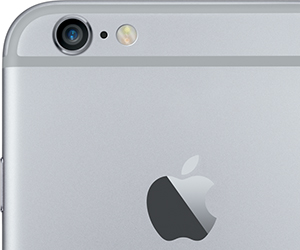
A tiny LED lamp appears next to this back lens—actually, it’s two lamps on the 5s, 6, and 6s iPhones, and four on the 7, 8, and X families. That’s the flash for the camera, the video light when you’re shooting movies, and a darned good flashlight for reading restaurant menus and theater programs in low light. (Swipe up from the bottom of the screen and tap the ![]() icon to turn the light on and off.)
icon to turn the light on and off.)
iPHONE X
Swipe down from the top right of the screen for the Control Center, where you’ll find the flashlight control.
The tiny pinhole between the flash and the lens is a microphone. It’s used for recording clearer sound with video, for better noise cancellation on phone calls, and for better directional sound pickup.
The iPhone Plus and X models actually have two lenses on the back—one wide-angle, one zoomed in. Details on this feature and everything else on the iPhone’s cameras are in Chapter 9.
Sensors
Behind the glass, above or beside the earpiece (and in the iPhone X Notch), are two sensors. (On the black iPhones, you can’t see them except with a flashlight.) First, there’s an ambient-light sensor that brightens the display when you’re in sunlight and dims it in darker places.
Second, there’s a proximity sensor. When something (like your head) is close to the sensor, it shuts off the screen and touch sensitivity. It works only in the Phone app. With the screen off, you save power and avoid dialing with your cheekbone when you’re on a call.
SIM Card Slot
On the right edge of the iPhone, there’s a pinhole next to what looks like a very thin slot cover. If you push an unfolded paper clip straight into the hole, the SIM card tray pops out.
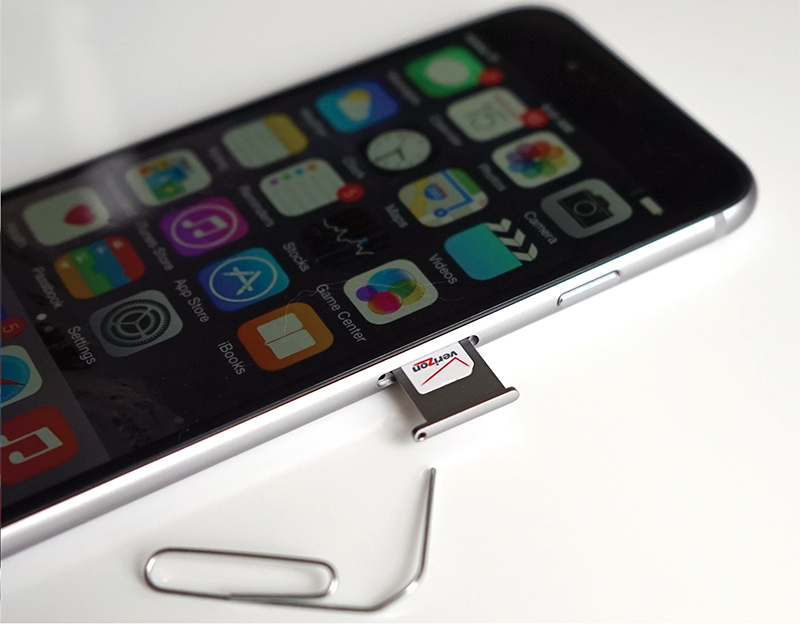
So what’s a SIM card?
It turns out that there are two major cellphone network types: CDMA, used by Verizon and Sprint, and GSM, used by AT&T, T-Mobile, and most other countries around the world.
Every GSM phone stores your phone account info—things like your phone number and calling-plan details—on a tiny memory card known as a SIM (subscriber identity module) card.
What’s cool is that, by removing the card and putting it into another GSM phone, you can transplant a GSM phone’s brain. The other phone now knows your number and account details, which can be handy when your iPhone goes in for repair or battery replacement. For example, you can turn a Verizon iPhone 8 into a T-Mobile iPhone 8 just by swapping in a T-Mobile SIM card.
The World Phone
AT&T is a GSM network, so AT&T iPhones have always had SIM cards. But, intriguingly enough, every iPhone has a SIM card, too—even the Verizon and Sprint models. That’s odd, because most CDMA cellphones don’t have SIM cards.
These iPhones contain antennas for both GSM and CDMA. It’s the same phone, no matter which cell company you buy it from. Only the SIM card teaches it which one it “belongs” to.
Even then, however, you can still use any company’s phone in any country. (That’s why the latest iPhones are said to be “world phones.”) When you use the Verizon or Sprint iPhone in the United States, it uses only the CDMA network. But if you travel to Europe or another GSM part of the world, you can still use your Verizon or Sprint phone; it just hooks into that country’s GSM network.
If you decide to try that, you have two ways to go. First, you can contact your phone carrier and ask to have international roaming turned on. You’ll keep your same phone number overseas, but you’ll pay through the nose for calls and, especially, Internet use. (One exception: On T-Mobile, international texting and Internet use are free.)
Second, you can rent a temporary SIM card when you get to the destination country. That’s less expensive, but you’ll have a different phone number while you’re there.
Apple thinks SIM cards are geeky and intimidating and that they should be invisible. That’s why, unlike most GSM phones, your iPhone came with the card preinstalled and ready to go. Most people never have any reason to open this tray.
If you were curious enough to open it up, you can close the tray simply by pushing it back into the phone until it clicks.
NOTE
Many countries offer LTE high-speed cellular Internet on all different radio frequencies. The iPhone 6 and later models can hop onto more of these networks than any other cellphones, but they still don’t work in every country. Ask your carrier which countries your model works with.
Headphone Jack
Until the iPhone 7 came along, iPhones contained a standard jack for plugging in the white earbuds that came with it—or any other earbuds or headphones.
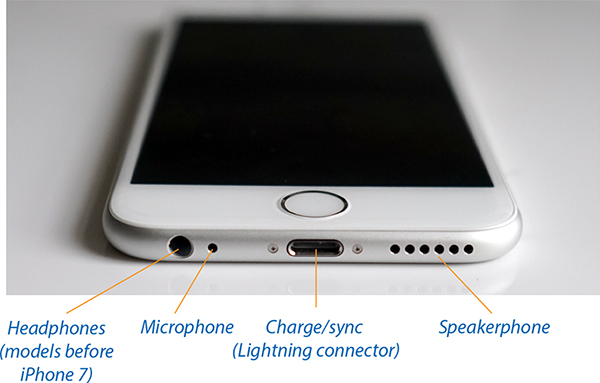
It’s more than an ordinary 3.5-millimeter audio jack, however. It contains a secret fourth pin that conducts sound into the phone from the microphone on the earbuds’ cord. You, too, can be one of those executives who walk down the street barking orders, apparently to nobody.
The iPhone can stay in your pocket. You hear the other person through your earbuds, and the mike on the cord picks up your voice.
NOTE
Next to the headphone jack, inside a perforated grille, a tiny second microphone lurks. It’s the key to the iPhone’s noise-cancellation feature. It listens to the sound of the world around you and pumps in the opposite sound waves to cancel out all that ambient noise. It doesn’t do anything for you—the noise cancellation affects what the other person on the phone hears.
That’s why there’s also a third microphone at the top back (between the camera and flash); it’s designed to supply noise cancellation for you so that the other person sounds better when you’re in a noisy place.
iPhone 7, 8, X: No Headphone Jack
We, the people, may complain about how exhausting it is to keep up with the annual flood of new smartphones. But at least we don’t have to think up a new set of features every year. That’s their problem.
Not just because it’s increasingly difficult to think of new features, but also because the phone makers have pretty much run out of room for new components inside.
That, says Apple, is why it removed the headphone jack from the iPhone 7 and later models. The headphone jack may not seem very big—but on the inside of the phone, the corresponding receptacle occupies an unnerving amount of nonnegotiable space.
So how are you supposed to listen to music without a headphone jack? Apple offers three ways:
Using the adapter. In the iPhone box, Apple includes a 2-inch adapter cord that connects any headphones to the phone’s Lightning (charging) jack.
Use the earbuds. The phone also comes with new white earbuds that connect to the Lightning jack.
TIP
Of course, if your headphones are plugged into the Lightning jack, you can’t charge your phone while listening over them. Fortunately, Amazon is full of cheap adapters that let you charge and plug in headphones simultaneously.
Use wireless headphones. You can also use any Bluetooth wireless earbuds—from $17 plastic disposable ones to Apple’s own, super-impressive AirPods. “FaceTime Audio Calls” has more on Bluetooth headsets.
In theory, those three approaches should pretty much cover you whenever you want to listen.
In practice, though, you’ll still get zapped by the occasional inconvenience. You’ll be on a flight, for example, listening to your laptop with headphones—and when you want to switch to the phone, you’ll realize that your adapter cord is in the overhead bin. (Based on a true story.)
But this kind of hassle is the new reality. Motorola, Google, and LeEco (in China) have already ditched the headphone jack on their phones, and other phone makers will follow suit.
Microphone, Speakerphone
On the bottom of the iPhone, Apple has parked two important audio components: the speaker and the microphone.
On the iPhone 7/8/X, actually, there are two speakers, on the top and bottom of the phone. Stereo sound has finally come to the iPhone.
TIP
The speakerphone isn’t super loud, because it’s aimed straight out of the iPhone’s edge, away from you. But if you cup your hand around the bottom, you can redirect the sound toward your face, for an immediate boost in volume and quality.
The Lightning Connector
On the bottom edge of the phone, right in the center, you’ll find the connector that charges and syncs the iPhone with your computer.
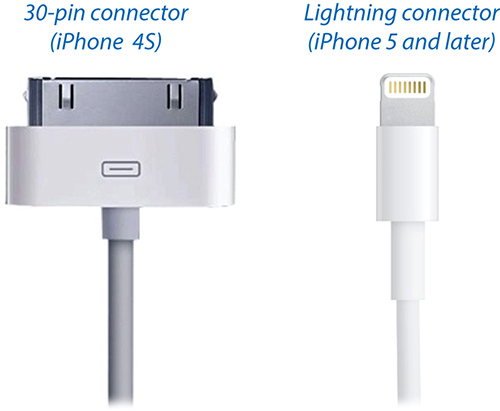
For nearly 10 years, the charge/sync connector was identical on every iPhone, iPod, and iPad—the famous 30-pin connector. But starting on the iPhone 5, Apple replaced that inch-wide connector with a new, far-smaller one it calls Lightning. The Lightning connector is a great design: It clicks nicely into place (you can even dangle the iPhone from it), yet you can yank it right out. You can insert the Lightning into the phone either way—there’s no “right-side up” anymore. It’s much sturdier than the old connector. And it’s tiny, which was Apple’s primary goal—only 0.3 inches wide (the old one was almost 0.9 inches wide).
Unfortunately, you may still occasionally encounter a car adapter or hotel-room alarm clock with the old kind of connector. (For $30, you can buy an adapter.)
Little by little, a new ecosystem of accessories based on the Lightning connector is arising. We’ll enjoy a new era of standardization—until Apple changes jacks again.
Antenna Band
Radio signals can’t pass through metal. That’s why there are strips or panels of plastic or glass on every iPhone.
And there are a lot of radio signals in this phone. All told, there are 20 different radio transceivers inside the modern iPhone. They tune in to the LTE and 3G (high-speed Internet) signals used in various countries around the world, plus the three CDMA signals used in the U.S.; and one each for Wi-Fi, Bluetooth, American GPS, and Russian GPS.
In the Box
Inside the minimalist box, you get the iPhone and these items:
A Lightning cable. When you connect your iPhone to your computer using this white USB cable, it simultaneously syncs and charges. See Chapter 15.
The AC adapter. When you’re traveling without a computer, you can plug the dock’s USB cable into the included two-prong outlet adapter, so you can charge the iPhone directly from a wall socket.
The earbuds. Every iPhone comes with a pair of the iconic white earbuds that announce to the world, “I have an iPhone!” These days, they’re what Apple calls EarPods. They sound great, although their bulbous shape may get uncomfortable in smaller ears. A volume control/clicker is right there on the cord, so you can answer phone calls and pause the music without even taking the phone out of your pocket. (The EarPods that come with the iPhone 7/8/X, of course, plug into the Lightning jack, since there’s no headphone jack. These phones also come with that 2-inch adapter cable for existing earbuds.)
Decals and info card. iPhone essentials.
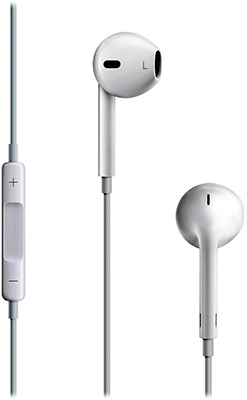
Seven Basic Finger Techniques
On the iPhone, you do everything on the touchscreen instead of with physical buttons.
Tap
The iPhone’s onscreen buttons are big, giving your fingertip a fat target.
You can’t use a fingernail or a pen tip; only skin contact works. (You can also buy an iPhone stylus. But a fingertip is cheaper and harder to misplace.)
Double-Tap
Double-tapping is generally reserved for two functions:
In the Safari, Photos, and Maps apps, double-tapping zooms in on whatever you tap, magnifying it. (At that point, double-tapping means “Restore to original size.”) Double-tapping also zooms in to formatted email messages, PDF files, Microsoft Office files, and other things.
When you’re watching a video (or recording one), double-tapping switches the aspect ratio (video screen shape).
Swipe
In some situations, you’re asked to confirm an action by swiping your finger across the screen. That’s how you confirm that you want to shut off the phone, for example. Swiping is also a great shortcut for deleting an email or a text message.
Pinch and Spread
In apps like Photos, Mail, Safari, and Maps, you can zoom in on a photo, message, web page, or map by spreading.
That’s when you place two fingers (usually thumb and forefinger) on the glass and spread them. The image magically grows, as though it’s printed on a sheet of rubber.

NOTE
The English language has failed Apple here. Moving your thumb and forefinger closer together has an appropriate verb: pinching. But there’s no good word to describe moving them the opposite direction.
Apple uses the oxymoronic expression pinch out to describe that move (along with the redundant-sounding pinch in). In this book, the opposite of “pinching” is “spreading.”
Once you’ve zoomed in like this, you can zoom out again by putting two fingers on the glass and pinching them together.
Drag
When you’re zoomed into a map, web page, email, or photo, you scroll around by sliding your finger across the glass in any direction—like a flick (described next), but slower and more controlled. It’s a huge improvement over scroll bars, especially when you want to scroll diagonally.
Flick
A flick is a faster, less-controlled drag. You flick vertically to scroll lists on the iPhone. The faster you flick, the faster the list spins downward or upward. But lists have a real-world sort of momentum; they slow down after a second or two, so you can see where you wound up.
At any point during the scrolling of a list, you can flick again (if you didn’t go far enough) or tap to stop the scrolling (if you see the item you want).
Edge Swipes
Swiping your finger inward from outside the screen has a few variations:
From the top edge. Opens the Notification Center, which lists all your missed calls and texts, shows your appointments, and so on.
iPHONE X
Swipe down from either the left ear or the Notch.
From the bottom edge. Opens the Control Center, a unified miniature control panel for brightness, volume, Wi-Fi, and so on.
iPHONE X
Swipe down from the right ear to open the Control Center.
From the left edge. In many apps, this means “Go back to the previous screen.” It works in Mail, Settings, Notes, Messages, Safari, Facebook, and some other apps. At the Home screen, it opens the Today screen (“The Today Screen (Widgets)”).
It sometimes makes a difference whether you begin your swipe within the screen or outside it. At the Home screen, for example, starting your downward swipe within the screen area doesn’t open the Notification Center—it opens the iPhone’s search function.
3D Touch
The screen on the iPhone 6s and later models doesn’t just detect a finger touch. It also knows how hard your finger is pressing, thanks to a technology Apple calls 3D Touch. This feature requires that you learn two more finger techniques.
Quick Actions
iOS interprets the pressure of your touch in various ways. On the Home screens, you can make a shortcut menu of useful commands pop out of various app icons, like this:
Apple calls these commands quick actions, and each is designed to save you a couple of steps. Some examples:
The Camera app icon offers shortcut menus like Take Selfie, Record Video, Record Slo-mo, and Take Portrait.
The Clock app gives you direct access to its Create Alarm, Start Timer, and Start Stopwatch functions.
Notes gives you New Note, New Checklist, New Photo, and New Sketch commands (a reference to the finger-drawing features). At the top, you see the last note you added or edited—not, for some reason, the note you’ve pinned to the top of the list (“The Notes List”).
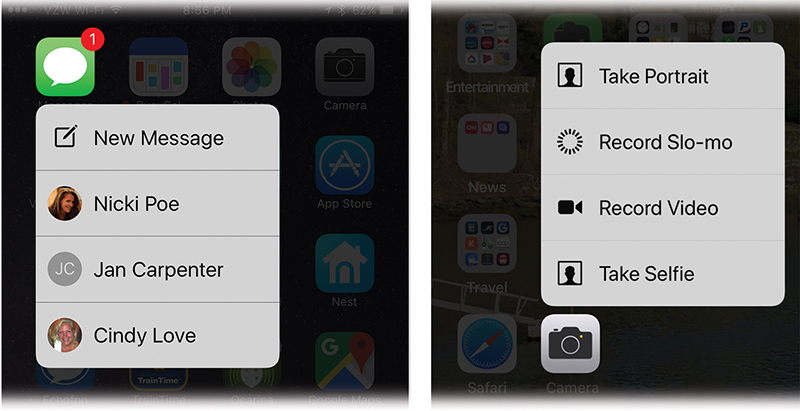
Maps offers Directions Home (a great one), Mark My Location, Send My Location, and Search Nearby (for restaurants, bars, shops, and so on). (When you already are home, you may see your travel time to work and the current traffic situation.)
The Phone app sprouts icons for people you’ve called recently, as well as commands like Create New Contact and View Most Recent Voicemail (handy!).
Calendar shows your next appointment, plus an Add Event command.
Reminders displays whatever To Do deadline is coming up next. It also lists your reminder categories, so you can create a new To Do directly inside one of them (for example, New in Family).
Mail and Messages offer New Message commands. Mail also offers Search, Inbox (with a new-message counter), and VIPs (also with a counter); Messages lists the three people with whom you text the most.
Home-screen folders sprout a Rename command at your fingertip.
The Notification Center (the list that appears when you swipe down from the top of the screen) offers a
 button. Hard-press it to reveal the Clear All Notifications command.
button. Hard-press it to reveal the Clear All Notifications command.The Control Center icons offer some very important, but very hidden options. See “Control Center”.
Similar quick actions also sprout from these Apple apps’ icons: Photos, Video, Wallet, iTunes Store, App Store, iBooks, News, Safari, Music, FaceTime, Podcasts, Voice Memos, Contacts, and Find My Friends.
And, of course, you can use hard presses to respond to notifications: Reply to a text message, accept a Calendar invitation, or see where your Uber is on a map.
Other software companies have added shortcut menus to their app icons, too—Facebook, Fitbit, Google Maps, and so on.
If you force-press an app that doesn’t have quick actions, you just feel a buzz and nothing else happens.
NOTE
At the outset, this force-pressing business can really throw you when you’re trying to rearrange icons on your Home screens. As described in “Two Welcome Notes About Backups”, that usually involves long-pressing an icon, which for most people is too similar to hard-pressing one. The trick is to long-press very lightly. You’ll get used to it.
Peek and Pop
Hard to explain, but very cool: You hard-press something in a list—your email Inbox, for example (below, left). Or a link in a text message, or a photo thumbnail. You get a pop-up bubble showing you what’s inside (middle):
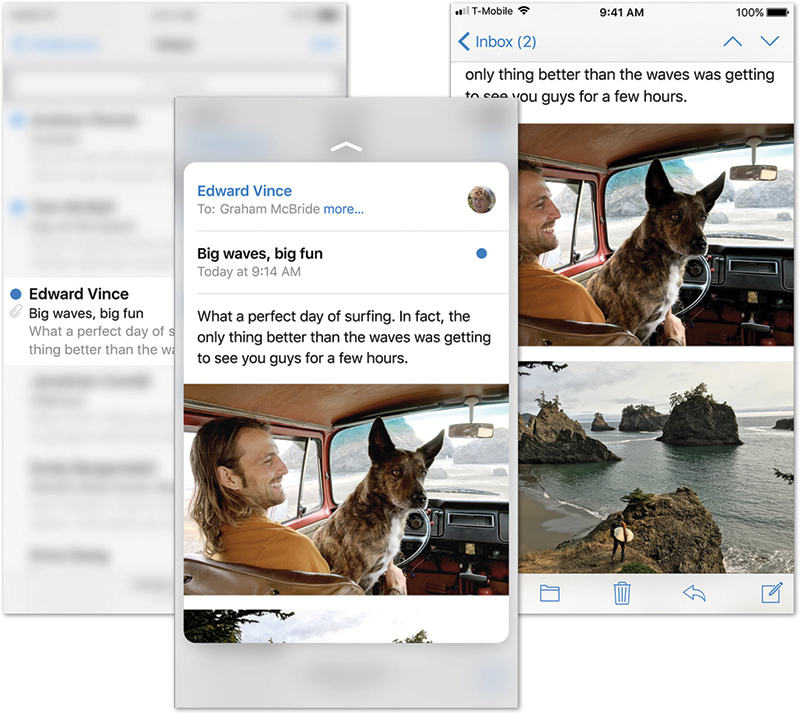
When you release your finger, the bubble disappears, and you’re right back where you started. Peeking, in other words, is exactly like the Quick Look feature on the Mac. It lets you see what’s inside a link, icon, or list item without losing your place or changing apps.
Email is the killer app here. You can whip through your Inbox, hard-pressing one new message after another—“What’s this one?” “Do I care?”—simply inspecting the first paragraph of each but not actually opening any message.
Then, if you find one that you do want to read fully, you can press harder yet to open the message normally (above, right). Apple calls that “popping.”
Here are some places where you can peek in the basic iPhone apps: Mail (preview a message in a list), Messages (see recent exchanges with someone in the list of people), Maps (preview information about a pushpin), Calendar (see details of an event), Photos (preview a photo in a screenful of thumbnails), Safari (preview the page hiding behind a link), Weather (see weather details for a name in the list of cities), Music (see information about a song or album in a list), Video (read details about a video in a list), Notes (see the contents of a note’s name in a list), iBooks (view a book-cover thumbnail larger), News (preview the body of an article in a list), and Find My Friends (see the map identifying the location of someone in your list).
If you do nothing else, at least get to know peek and pop in Mail and Messages. It’s really kind of awesome.
And, again, app makers can add this feature to their own apps.
Charging the iPhone
The iPhone has a built-in, rechargeable battery that fills up most of its interior. How long a charge lasts depends on what you’re doing—music playback saps the battery the least; games and GPS navigation sap it the most. But one thing is for sure: You’ll have to recharge the iPhone regularly. For most people, it’s every night.
NOTE
The iPhone’s battery isn’t user-replaceable. It’s rechargeable, but after 400 or 500 charges, it starts to hold less juice. Eventually, you’ll have to pay Apple to install a new battery. (Apple says the added bulk of a protective plastic battery compartment, a removable door and latch, and battery-retaining springs would have meant a much smaller battery—or a much thicker iPhone.)
Charging with the Cable
You recharge the iPhone by connecting the white USB cable that came with it. You can plug the far end into either of two places to supply power:
Your computer’s USB jack. In general, the iPhone charges even if your computer is asleep. (If it’s a laptop that itself is not plugged in, though, the phone charges only if the laptop is awake. Otherwise, you could come home to a depleted laptop.)
The AC adapter. The little white two-prong cube that came with the iPhone connects to the end of the cradle’s USB cable.
Unless the charge is really low, you can use the iPhone while it charges. The battery icon in the upper-right corner displays a lightning bolt to let you know it’s charging.
TIP
If you have an iPhone 6 or later, it’ll charge much faster if you charge it with the 2.1-amp wall adapter that comes with an iPad, instead of the 1-amp adapter that comes with the phone. How’s a 90 percent charge in two hours sound?
Better yet: If you have an iPhone 8 or X, you can get really fast charging—along the lines of 50 percent charge in 30 minutes—but only if you connect it to a USB-C power brick plugged into the wall. Apple sells one for $50—but the cable you need (USB-C to Lightning) isn’t included. That’s another $25. Fast charging is cool, but it ain’t cheap.
Charging on a Pad (iPhone 8 and X)
iPhone fans can stop looking over at Samsung owners with envy: Now you, too, can recharge your phone just by setting it down on a Qi charging pad.
NOTE
Qi, pronounced “chee,” is the Chinese word for the life force in everyone and everything. It’s also an extraordinarily useful word to know if you’re playing Scrabble.
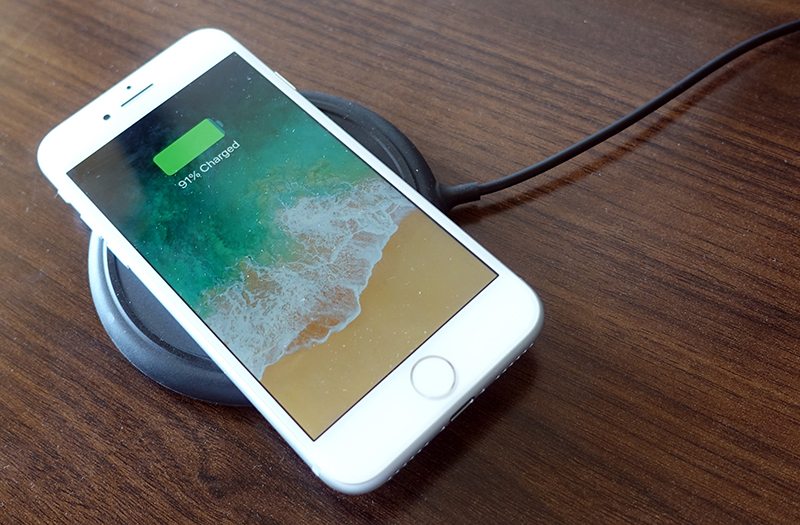
You can buy one of these tabletop charging pads from any company; they cost about $12 on Amazon. (Surprisingly, at the dawn of the iPhone 8, Apple didn’t even offer one. The company is working on a super-wide one for release in 2018, called the AirPower pad, that can charge an iPhone, an Apple Watch, and a special AirPods case simultaneously.)
You have to plug the pad into a power outlet, of course—wireless charging isn’t really wireless at all. But at least you’re spared the hassle of plugging and unplugging a cable every night. You just place the iPhone’s back onto the pad, and boom: The little lightning-bolt icon appears, and the little “now charging” chime sounds.
Some fun facts about speed:
Charging a dead iPhone for two hours brings it to about 80 percent charge if you use the Lightning cable; to about 50 percent if you use “fast charging” (on a compatible 7.5-watt pad); and about 40 percent with regular charging (5-watt pads).
If you plug in the Lightning cable and put the phone on the charging pad, you don’t cut the time in half. In that situation, the cable wins. The pad does nothing.
If you want really fast charging—a 50 percent charge in 30 minutes—buy a USB-C power brick ($50 and up) and a USB-C to Lightning cable (Apple’s is $25).
Battery Life Tips
For most people, the battery life of the iPhone is about a day. But if you can’t even make it to bedtime, then knowing how to scale back your iPhone’s power appetite should come in extremely handy.
These are the biggest wolfers of electricity: the screen and background activity (especially Internet activity). Therefore, when you’re nervous about your battery making it through an important day, here are your options:
Low Power mode can squeeze another three hours of life out of a charge.
In Low Power mode, your iPhone quits doing a lot of stuff in the background, like fetching new mail and updating apps. It also stops playing most of iOS’s cute animations and stops listening for you to say “Hey Siri” (“How to Use “Hey Siri””). The processor slows down, too; it takes longer to switch between apps, for example. And the battery indicator turns yellow, to remind you why things have suddenly slowed down.
Unless you’ve fiddled with the settings, you get an invitation to turn on Low Power mode when your battery sinks to 20 percent remaining, and then again at 10 percent. You can also turn on this mode manually, using the Control Center (“Control Center”) or the switch in Settings → Battery (below, top right).
If your phone is plugged in, it exits Low Power mode automatically once it has enough juice (below, lower right).
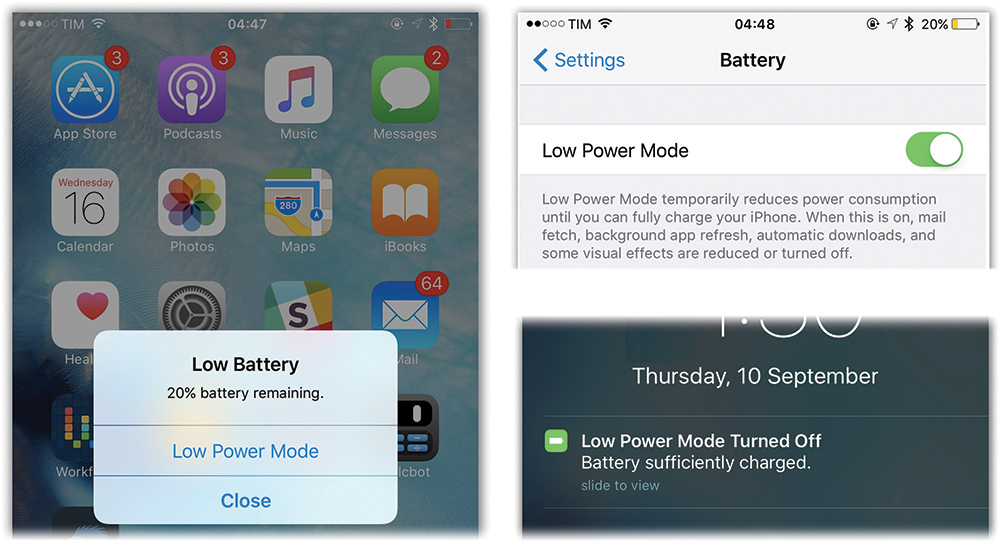
At any time, you can also shut down juice-guzzling features manually. Here they are, roughly in order of power appetite:
Dim the screen. Turning down your screen saves a lot of battery power. The quickest way is to open the Control Center (“Control Center”), and then drag the brightness slider.
On a new iPhone, Auto-Brightness is turned on, too. In bright light, the screen brightens automatically; in dim light, it darkens. That’s because when you unlock the phone after waking it, it samples the ambient light and adjusts the brightness.
NOTE
This works because of the ambient-light sensor near the earpiece. Apple says it experimented with having the light sensor active all the time, but it was weird to have the screen constantly dimming and brightening as you used it.
(You can turn this auto-brightness feature off in Settings → Display & Brightness.)
TIP
You can set things up so that a triple-click on the home button or side button instantly dims your screen, for use in the bedroom, movie theaters, or planetariums—without having to fuss with settings or sliders. See “The Instant Screen-Dimming Trick” for this awesome trick.
Turn off “push” data. This is a big one. If your email, calendar, and address book are kept constantly synced with your Macs or PCs, then you’ve probably gotten yourself involved with Yahoo Mail, iCloud (Chapter 16), or Microsoft Exchange. It’s pretty amazing to know that your iPhone is constantly kept current with the mother ship.
Unfortunately, all that continual sniffing of the airwaves, looking for updates, costs you battery life. If you can do without the immediacy, visit Settings → Accounts & Passwords → Fetch New Data. If you turn off the Push feature for each email account and set it to Manually instead, then your iPhone checks for email and new appointments only when you actually open the Mail or Calendar apps. Your battery goes a lot further.
Beware GPS. GPS navigation, in Maps or Google Maps, drains your battery power like a hole in a water bucket. So as you drive, once your guidance app has led you to a place you recognize, by all means shut it off.
But there’s more. In Settings → Privacy → Location Services, there’s a list of all the apps on your phone that are using its location feature to know where you are. (It’s a combination of GPS, cell-tower triangulation, and Wi-Fi hotspot triangulation.) And it uses battery power.
Some apps, like Maps, Find My Friends, and Yelp, don’t do you much good unless they know your location. But plenty of others don’t really need to know where you are. Facebook and Twitter, for example, want that information only so that they can location-stamp your posts. In any case, the point is to turn off Location Services for each app that doesn’t really need to know where you are.
TIP
In the list of apps under Location Services, tiny ![]() icons show you which apps are using GPS right now and which have used it in the past 24 hours. These icons can guide you in shutting off the GPS use of various apps.
icons show you which apps are using GPS right now and which have used it in the past 24 hours. These icons can guide you in shutting off the GPS use of various apps.
Turn off background updating. Non-Apple apps check for frequent updates, too: Facebook, Twitter, stock-reporting apps, and so on. Not all of them need to be busily toiling in the background. Your best bet for battery life, then, involves visiting Settings → General → Background App Refresh and turning the switch off for each app whose background activity isn’t strictly necessary.
Turn off automatic app updates. As you’ll soon discover, app companies update their wares far more often than PC or Mac apps. Some get updated many times a year. Your phone comes set to download them automatically when they become available. But that constant checking and downloading costs you battery life.
To shut that feature down, open Settings → iTunes & App Store. In the Automatic Downloads section, turn off Updates. (The other switches—Music, Apps, Books—are responsible for auto-downloading things that you or your brood have downloaded on other iOS gadgets. You might want to make sure they’re off, too, if battery life is a concern.)
Turn off Wi-Fi. If you’re not in a wireless hotspot, you may as well stop the thing from using its radio. Open the Control Center and tap the
 icon to turn it off.
icon to turn it off.Or at the very least tell the iPhone to stop searching for Wi-Fi networks it can connect to. “Sequence of Connections” has the details.
Turn off Bluetooth. If you’re not using a Bluetooth gadget (headset, fitness band, or whatever), then for heaven’s sake shut down that Bluetooth radio. Open the Control Center and tap the
 icon to turn it off.
icon to turn it off.Turn off Cellular Data. This option (in Settings → Cellular, but there’s also a Control Center button for it) turns off the cellular Internet features of your phone. You can still make calls, and you can still get online in a Wi-Fi hotspot.
This feature is designed for people who have a capped data plan—a limited amount of Internet use per month—which is a lot of people. If you discover that you’ve used up almost all your data allotment for the month, and you don’t want to go over your limit (and thereby trigger an overage charge), you can use this option to shut off all data. Now your phone is just a phone—and it uses less power.
Consider airplane mode. In airplane mode, you shut off all the iPhone’s power-hungry radios. Even a nearly dead iPhone can hobble on for a few hours in airplane mode—something to remember when you’re desperate. To enter airplane mode, tap the
 icon in the Control Center (“Control Center”).
icon in the Control Center (“Control Center”).
TIP
For sure turn on airplane mode if you’ll be someplace where you know an Internet signal won’t be present—like on a plane, a ship at sea, or Montana. Your iPhone never burns through a battery charge faster than when it’s hunting for a signal it can’t find; your battery will be dead within a couple of hours.
Turn off the screen. With a press of the side button, you can turn off the screen, rendering it black and saving huge amounts of power. That won’t interrupt audio playback, like music or podcasts, or Maps navigation.
Of course, if you want to actually interact with the phone while the screen is off, you’ll have to learn the VoiceOver talking-buttons technology; see “VoiceOver”.
By the way, beware of 3D games and other graphically intensive apps, which can be serious power hogs. And turn off EQ when playing your music (see “Switching Among Speakers”).
If your battery still seems to be draining too fast, check out the table at right, which shows you exactly which apps are using the most power:
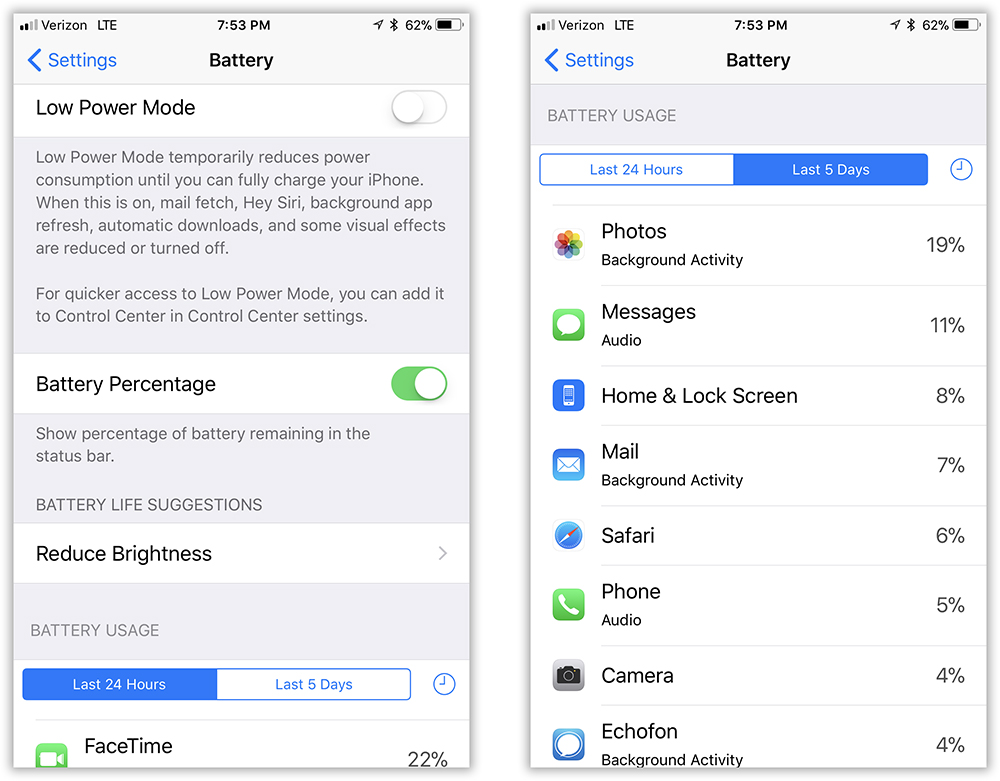
To see it, open Settings → Battery. You can switch between battery readouts for the past 24 hours, or for the past seven days.
Keep special watch for labels like these:
Low Signal. A phone uses the most power of all when it’s hunting for a cellular signal, because the phone amplifies its radios in hopes of finding one. If your battery seems to be running down faster than usual, the “Low Signal” notation is a great clue—and a suggestion that maybe you should use airplane mode when you’re on the fringes of cellular coverage.
Background activity. As hinted on the previous pages, background Internet connections are especially insidious. These are apps that do online work invisibly, without your awareness—and drain the battery in the process. Now, for the first time, you can clearly see which apps are doing it.
Once you know the culprit app, it’s easy to shut its background work down. Open Settings → General → Background App Refresh and switch off each app whose background activity isn’t strictly necessary.
TIP
If you tap the little ![]() in Settings → Battery (previous page, right), the screen shows you how much time each app has spent running—both in the foreground and in the background. It’s an incredibly informative display if you’ve been wondering where all your battery power has been going.
in Settings → Battery (previous page, right), the screen shows you how much time each app has spent running—both in the foreground and in the background. It’s an incredibly informative display if you’ve been wondering where all your battery power has been going.
The Home Screen
The Home screen is the launching pad for every iPhone activity. It’s what appears when you press the home button or swipe up on the screen (iPhone X). It’s the immortal grid of colorful icons.
It’s such an essential software landmark, in fact, that a quick tour might be helpful:
Icons. Each icon represents one of your iPhone apps (programs)—Mail, Maps, Camera, and so on—or a folder that you’ve made to contain some apps. Tap one to open that app or folder.
Your iPhone comes with a couple of dozen apps preinstalled by Apple; you can’t remove them. The real fun, of course, comes when you download more apps from the App Store (Chapter 10).
Badges. Every now and then, you’ll see a tiny red number “badge” (like
 ) on one of your app icons. It’s telling you that something new awaits: new email, new text messages, new chat entries, new updates for the apps on your iPhone. It’s saying, “Hey, you! Tap me!”
) on one of your app icons. It’s telling you that something new awaits: new email, new text messages, new chat entries, new updates for the apps on your iPhone. It’s saying, “Hey, you! Tap me!”Home page dots. The standard Home screen can’t hold more than 20 or 24 icons. As you install more and more programs on your iPhone, you’ll need more and more room for their icons. Fortunately, the iPhone makes room for them by creating additional Home screens automatically. You can spread your new programs’ icons across 11 such launch screens.
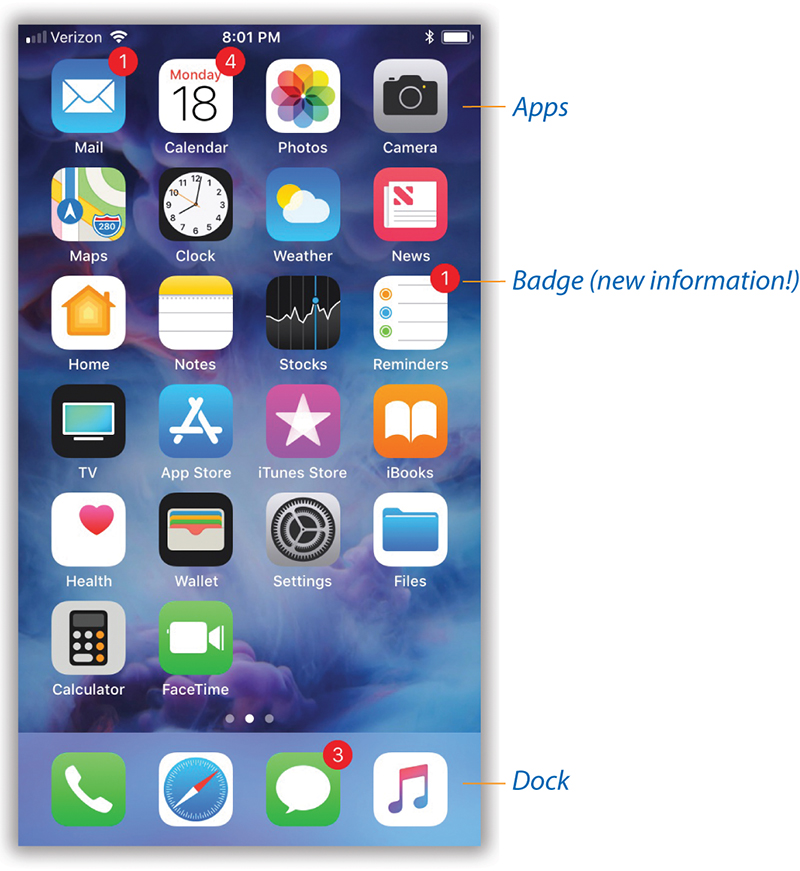
The little white dots are your map. Each represents one Home screen. If the third one is “lit up,” then you’re on the third Home screen.
To move among the screens, swipe horizontally—or tap to the right or left of the little dots to change screens.
And if you ever scroll too far from the first Home screen, here’s a handy shortcut: Press the home button (yes, even though you’re technically already home). That takes you back to the first Home screen.
iPHONE X
Swipe a finger up from the bottom of the screen instead.
The Dock. At the bottom of the Home screen, four exalted icons sit in a row on a light-colored panel. This is the Dock—a place to park the most important icons on your iPhone. These, presumably, are the ones you use most often. Apple starts you off with the Phone, Mail, Safari, and Music icons there.
What’s so special about this row? As you flip among Home screens, the Dock never changes. You can never lose one of your four most cherished icons by straying from the first page; they’re always handy.
The background. You can replace the background image (behind your app icons) with a photo. A complicated, busy picture won’t do you any favors—it will just make the icon names harder to read—so Apple provides a selection of handsome, relatively subdued wallpaper photos. But you can also choose one of your own photos.
For instructions on changing the wallpaper, see “Wallpaper”.
It’s easy (and fun!) to rearrange the icons on your Home screens. Put the most frequently used icons on the first page, put similar apps into folders, and reorganize your Dock. Full details are in “Two Welcome Notes About Backups”.
TIP
You can set up a nearly empty first Home screen by moving all of its app icons onto other home pages, if you want. That’s a weird but fun arrangement for anyone with a really great wallpaper photo.
Control Center
For such a tiny device, there are an awful lot of settings you can change—hundreds of them. Trouble is, some of them (volume, brightness) need changing a lot more often than others (language preference, voicemail greeting).
That’s why Apple invented the Control Center: a panel that offers quick access to the controls you need the most.
In iOS 11, the Control Center is no longer a stunted toddler; it has blossomed into the magnificence of adulthood. Now you decide which controls should appear on it. And you no longer have to hunt among multiple pages to find the one you want; the Control Center is once again a single screen. If you’re a true Control freak, it even scrolls.
To open the Control Center, no matter what app you’re using, swipe upward from beneath the screen. You can even open it from the Lock screen (unless you’ve turned off that feature in Settings → Control Center → Access on Lock Screen).
iPHONE X
Swipe down from the upper-right ear. In iOS 11.2, a small horizontal bar appears there to remind you, as shown in “iPhone X: The Notch”.
Now, it’s worth pointing out that many of the Control Center’s settings are even faster to change using Siri, as described in Chapter 5. When it’s not socially awkward to speak to your phone (like at the symphony or during a golf game), you can use spoken commands to adjust settings without even touching the screen.
The Starter Set
Yes, you can customize what appears on the Control Center. But the following controls are nonnegotiable. They’re your starter set, and you can’t remove most of them.
TIP
In many cases, you can hard-press or long-press one of these buttons to open a sub-panel that offers even more controls (next page, right). Apple greatly expanded this feature in iOS 11, so the following writeup dives into those hard-press options in detail.
Airplane mode (
 ). Tap to turn the icon orange. Now you’re in airplane mode; the phone’s wireless features are all turned off. You’re saving the battery and obeying flight attendant instructions. Tap again to turn off airplane mode.
). Tap to turn the icon orange. Now you’re in airplane mode; the phone’s wireless features are all turned off. You’re saving the battery and obeying flight attendant instructions. Tap again to turn off airplane mode.Sample Siri command: “Turn airplane mode on.” (Siri warns you that if you turn airplane mode on, Siri herself will stop working. Say “OK.”)
Cellular data (
 ). This icon is new in iOS 11. It’s the on/off switch for your iPhone’s connection to the Internet over the cellular airwaves (rather than Wi-Fi). Cellular data, after all, costs you money—especially when you’re roaming (“Cellular”)—and you may have a monthly limit. So it’s good to be able to control when you’re using it up.
). This icon is new in iOS 11. It’s the on/off switch for your iPhone’s connection to the Internet over the cellular airwaves (rather than Wi-Fi). Cellular data, after all, costs you money—especially when you’re roaming (“Cellular”)—and you may have a monthly limit. So it’s good to be able to control when you’re using it up.Sample Siri command: “Turn off cellular data.”
Wi-Fi (
 ). Tap to turn your phone’s Wi-Fi off (gray) or on (blue).
). Tap to turn your phone’s Wi-Fi off (gray) or on (blue).Sample Siri commands: “Turn off Wi-Fi.” “Turn Wi-Fi back on.”
Bluetooth (
 ). Tap to turn your Bluetooth transmitter off (gray) or on (blue). That feature alone is a godsend to anyone who uses the iPhone with a car’s Bluetooth audio system. Bluetooth isn’t the battery drain it once was, but it’s still nice to be able to flick it on so easily when you get into the car.
). Tap to turn your Bluetooth transmitter off (gray) or on (blue). That feature alone is a godsend to anyone who uses the iPhone with a car’s Bluetooth audio system. Bluetooth isn’t the battery drain it once was, but it’s still nice to be able to flick it on so easily when you get into the car.Sample Siri commands: “Turn Bluetooth on.” “Turn off Bluetooth.”
Hard-press options: If you hard-press or long-press anywhere in this cluster of four wireless buttons, you pop open a new panel. It offers the same buttons—Airplane Mode, Cellular Data, WiFi, Bluetooth—with labels, this time, along with two more.
First, there’s AirDrop (
 ). This feature gives you a quick, effortless way to shoot photos, maps, web pages, and other stuff to nearby iPhones, iPads, iPod Touches, and even Macs. (See “AirDrop” for details.) It used to be on the Control Center itself but has now been buried on this sub-panel. Tap it to see the AirDrop controls described in “AirDrop”.
). This feature gives you a quick, effortless way to shoot photos, maps, web pages, and other stuff to nearby iPhones, iPads, iPod Touches, and even Macs. (See “AirDrop” for details.) It used to be on the Control Center itself but has now been buried on this sub-panel. Tap it to see the AirDrop controls described in “AirDrop”.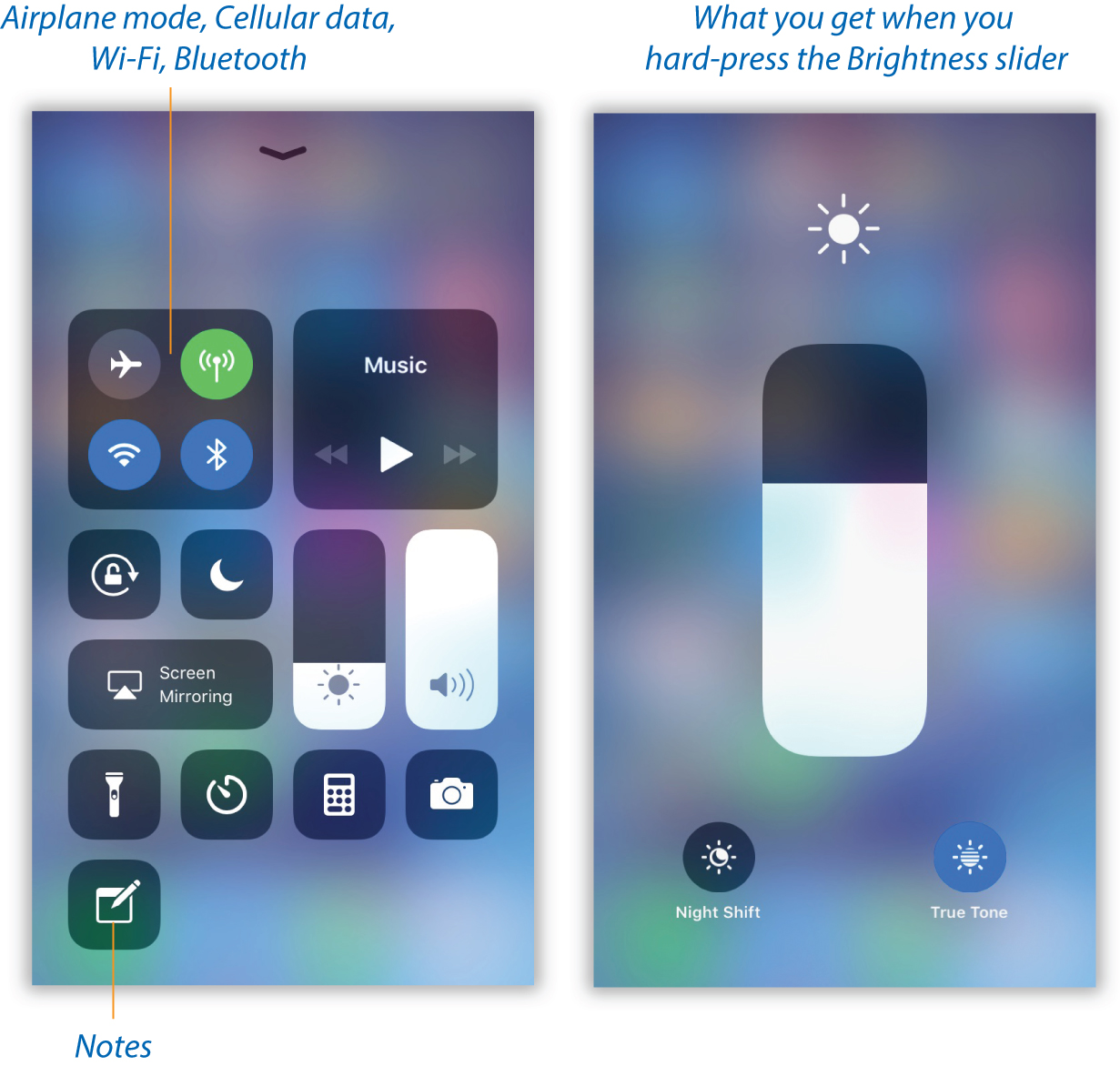
Second, there’s Personal Hotspot, which lets your phone act as a Wi-Fi hotspot for your laptop or other gadgets (“Personal Hotspot (Tethering)”). It makes its first Control Center appearance in iOS 11.
Music. Praise the software gods: The music playback controls are no longer hiding on a separate page of the Control Center. Right here on this little tile, you see information about the current song, plus playback controls (
 ).
).These controls govern playback in whatever app is playing music or podcasts in the background: the Music app, Pandora, Spotify, whatever it is. You can skip a horrible song quickly and efficiently without having to interrupt what you’re doing, or pause the music to chat with a colleague.
Sample Siri commands: “Pause the music.” “Skip to the next song.” “Play some Billy Joel.”
Hard-press options: The sub-panel offers a scrubber bar that shows where you are in the song, the album art, and a little button (
 ) that lets you choose what speaker you want to use. It always lists iPhone (the built-in speakers), but it may also list things like a Bluetooth speaker, earbuds, or AirPlay, which sends music or video to a wireless speaker system or TV (see “TV Output”).
) that lets you choose what speaker you want to use. It always lists iPhone (the built-in speakers), but it may also list things like a Bluetooth speaker, earbuds, or AirPlay, which sends music or video to a wireless speaker system or TV (see “TV Output”).There’s also a volume slider. It lets you make big volume jumps faster than you can by pressing the volume buttons on the side of the phone.
Rotation lock (
 ). When rotation lock is turned on (red), the screen no longer rotates when you turn the phone 90 degrees. The idea is that sometimes, like when you’re reading an ebook on your side in bed, you don’t want the screen picture to turn; you want it to stay upright relative to your eyes. (A little
). When rotation lock is turned on (red), the screen no longer rotates when you turn the phone 90 degrees. The idea is that sometimes, like when you’re reading an ebook on your side in bed, you don’t want the screen picture to turn; you want it to stay upright relative to your eyes. (A little  icon appears at the top of the screen to remind you why the usual rotating isn’t happening. On the iPhone X, open the Control Center to see that icon.)
icon appears at the top of the screen to remind you why the usual rotating isn’t happening. On the iPhone X, open the Control Center to see that icon.)The whole thing isn’t quite as earth-shattering as it sounds—first, because it locks the image in only one way: upright, in portrait orientation. You can’t make it lock into widescreen mode. Furthermore, many apps don’t rotate with the phone to begin with. But when that day comes when you want to read in bed on your side with your head on the pillow, your iPhone will be ready. (Tap the button again to turn rotating back on.)
There are no Siri or hard-press options for this control.
Do Not Disturb (
 ). Do Not Disturb mode, described in “Do Not Disturb”, means that the phone won’t ring or buzz when people call—except a few handpicked people whose communiqués are allowed to ring through. Perfect for sleeping hours; in fact, you can set up an automated schedule for Do Not Disturb (midnight to 7 a.m., say).
). Do Not Disturb mode, described in “Do Not Disturb”, means that the phone won’t ring or buzz when people call—except a few handpicked people whose communiqués are allowed to ring through. Perfect for sleeping hours; in fact, you can set up an automated schedule for Do Not Disturb (midnight to 7 a.m., say).But what if you wake up early or want to stay up late? You can tap to turn Do Not Disturb on (blue) or off (gray).
There are no hard-press options for this control.
Sample Siri commands: “Turn on Do Not Disturb.” “Turn Do Not Disturb off.”
Brightness (
 ). Hallelujah! Here’s a screen-brightness slider—now in the form of a big, fat vertical bar that’s very easy to operate. Drag anywhere within it, up or down, to change the brightness.
). Hallelujah! Here’s a screen-brightness slider—now in the form of a big, fat vertical bar that’s very easy to operate. Drag anywhere within it, up or down, to change the brightness.Sample Siri commands: “Make the screen brighter.” “Dim the screen.”
Hard-press options: The sub-panel presents on/off buttons for Night Shift, which makes the screen yellower before bedtime to prevent sleep disturbance (“Display & Brightness”), and True Tone, a feature of the iPhone 8 and X that tweaks the screen colors to make them look consistent in whatever ambient light you’re in (“Display & Brightness”).
Volume (
 ). Here it is, next to brightness: an equally big, fat volume slider. Slide your finger up or down to adjust the audio volume.
). Here it is, next to brightness: an equally big, fat volume slider. Slide your finger up or down to adjust the audio volume.Hard-press options: Hard-pressing doesn’t gain you any new controls. It does, however, open up a much bigger version of the volume slider. It’s now easier to make finer adjustments.
AirPlay Mirroring (
 ). The AirPlay button lets you send your iPhone’s video and audio to a wireless speaker system or TV—if you have an AirPlay receiver, of which the most famous is the Apple TV. Details are in “TV Output”.
). The AirPlay button lets you send your iPhone’s video and audio to a wireless speaker system or TV—if you have an AirPlay receiver, of which the most famous is the Apple TV. Details are in “TV Output”.Hard-press options: A sub-panel appears, listing any available wireless receivers, like an Apple TV or a wireless projector.
The bottom row of the starter icons, described next, are removable. If they’re not floating your boat, see the next section for instructions on how to get rid of them.
Flashlight (
 ). Tap to turn on the iPhone’s “flashlight”—actually the LED lamp on the back that usually serves as the camera flash. Knowing that a source of good, clean light is a few touches away makes a huge difference if you’re trying to read in the dark, find your way along a path at night, or fiddle with wires behind your desk.
). Tap to turn on the iPhone’s “flashlight”—actually the LED lamp on the back that usually serves as the camera flash. Knowing that a source of good, clean light is a few touches away makes a huge difference if you’re trying to read in the dark, find your way along a path at night, or fiddle with wires behind your desk.iPHONE X
There’s also a flashlight button right on the Lock screen. Press it hard to turn it on.
Hard-press options: You get a four-segment “slider” that controls the flashlight’s brightness. The top segment means full brightness; the bottom one means Off. That’s super cool, especially on the iPhone 7/8/X, whose LED flashlight is enough to light up a high-school football game at night.
Camera (
 ). Tap to jump directly into the Camera app. Because photo ops don’t wait around.
). Tap to jump directly into the Camera app. Because photo ops don’t wait around.Hard-press options: Handy! Here are the Take Selfie, Record Video, Record Slo-mo, and (on Plus and X models) Take Portrait commands. Each saves you a little fiddling in the Camera app.
Sample Siri commands: “Take a picture.” “Open the camera.”
Calculator (
 ). Tap to open the Calculator app—a handy shortcut if it’s your turn to figure out how to divide up the restaurant bill.
). Tap to open the Calculator app—a handy shortcut if it’s your turn to figure out how to divide up the restaurant bill.Hard-press options: A Copy Last Result button appears, so you can snag whatever.
Sample Siri commands: “Open the calculator.” Or, better yet, without opening any app: “What’s a 106 divided by 5?”
Timer (
 ). Tap to open the Clock app—specifically, the Timer mode, which counts down to zero. Apple figures you might appreciate having direct access to it when you’re cooking, for example, or waiting for your hair color to set.
). Tap to open the Clock app—specifically, the Timer mode, which counts down to zero. Apple figures you might appreciate having direct access to it when you’re cooking, for example, or waiting for your hair color to set.There are no hard-press options for this icon.
Sample Siri commands: “Open the Timer.” Or, better yet, bypass the Clock and Timer apps altogether: “Start the timer for three minutes.” “Count down from six minutes.” (Siri counts down right there on the Siri screen.)
Customizing the Control Center
This is one of the biggest chunks of good news in iOS 11: You can make Control Center your own. You can add all kinds of new buttons to it, including some (like recording a video of the screen) that have never been possible on the iPhone before.
The Center for Control Center Customization, as it turns out, is Settings → Control Center → Customize Controls. Here’s a giant list of the buttons you’re allowed to add or remove. It’s very simple: Tap ![]() to remove a button that’s already installed. Tap
to remove a button that’s already installed. Tap ![]() to install a button that’s not yet on the Control Center.
to install a button that’s not yet on the Control Center.
And drag the little ![]() handles up or down to choose an order for your icons on the Control Center.
handles up or down to choose an order for your icons on the Control Center.
Here are your options (except as noted, none of them offer further options when you hard-press):
Flashlight, Camera, Calculator, Stopwatch. As described previously.
Stopwatch. Tap to open the Clock app, already tuned to the Stopwatch mode (“Stopwatch”). You’re all ready to time that 50-yard dash or teenage room-cleaning.
Accessibility Shortcuts. Opens the same list of accessibility shortcuts (Zoom, VoiceOver, AssistiveTouch, and so on) that you’ve chosen to list for quick access when you triple-click the home button. These options, and the triple-clicking business, are described in ???.
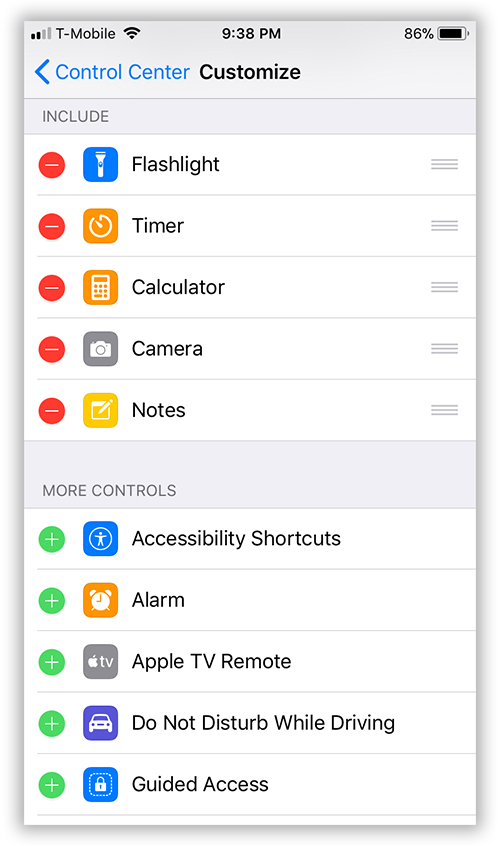
Alarm. Tap to open the Clock app, this time set to Alarm mode (“Alarm”), where you can set (or turn off) an upcoming alarm.
Apple TV Remote. Pops open an onscreen version of your Apple TV remote control, complete with Menu, Play, and Siri buttons—plus a large trackpad area for scrolling around. This item is fantastic when you can’t seem to dig your actual Apple TV remote from under the couch cushions.
Do Not Disturb While Driving. Apple is very proud of this new iOS 11 feature, which prevents notifications, calls, or texts from lighting up your phone or making it ring whenever you’re behind the wheel and in motion.
You can read all about this feature in “Allowing Special Callers Through”. There you’ll learn that you can (and probably should) set it to turn on automatically when you’re driving. In other words, this button is primarily useful for turning DNDWD off—when you’re in the passenger seat.
Guided Access. Opens the on/off switch for Guided Access, otherwise known as “kiosk mode.” It locks the phone into one particular app, so that (for example) your toddler can play with it without wreaking any real havoc on your phone. See “Guided Access (Kiosk Mode)”.
Low Power Mode. Here’s a one-touch way to manually switch on the battery-saving feature known as Low Power Mode (“Battery Life Tips”).
Magnifier. Turns the entire phone into a powerful illuminated magnifying glass, as described in “Magnifier”.
Notes. This is a big, big deal. The idea is to give you immediate access to Notes, so you can jump in, no matter what you were doing, to write down something quickly: a phone number someone’s giving you, dosage instructions your doctor’s rattling off, or a brainstorm you’ve just had for a million-dollar product.
TIP
One tap opens directly into the Notes app. But if you hard-press instead, you get a list of commands like New Note, New Checklist, New Photo, and New Sketch.
Now then. If you make Notes part of the Control Center, it will be available even when the phone is locked. Clearly, that could be a privacy disaster if your phone falls into the hands of some passing evildoer.
Apple has given that scenario a lot of thought. First of all, if you open Notes from the Lock screen, there’s no way to see any existing notes. You’re stuck on a single page.
But that’s not the end of the privacy control—oh, heavens, no. Open Settings → Notes → Access Notes from Lock Screen.
At the top, you have three choices. Off means forget it—you can’t open Notes from the Lock screen at all. (So why bother putting the Notes button on the Control Center? Because you can still use it when the phone isn’t locked.)
Always Create New Note means that every time you open Notes from the Lock screen, you wind up at another fresh, empty Notes page.
And Resume Last Note…well, if you choose this option, Settings has a whole bunch more questions for you.
For example, if you open Notes from the Lock screen, do you want it to reopen the last note you viewed in the app? Or just the last note you opened from the Lock screen? That second option is another security precaution, keeping your Lock-screen doodlings separate from your other stuff.
You also get a bunch of time settings, like After 5 Minutes, After 15 Minutes, and so on. What Apple is saying here: “Even though you’ve selected Resume Last Note, you’re still going to get a new, empty note if it’s been at least five minutes since the last time you looked at it. Just in case you wander off during a meeting and some idiot picks up your phone six minutes later to see what you were writing.”
Once Daily here means that you’ll get a new, fresh note the first time you open Notes from the Lock screen each day—handy for a journal or a daily log.
Finally, Never ignores all these options. It means that every time you open Notes from the Lock screen, you’ll return to whatever Note page you’ve been working on.
And if all of these options make sense to you, there are fine career opportunities awaiting you at the Internal Revenue Service.
Screen Recording. Here’s a freak of iOS nature: a Control Center button for a feature you can’t trigger in any other way. The idea, of course, is to let you record videos of what’s happening on the iPhone screen—with narration, if you like. See “Recording Screen Video” for details.
Text Size. There are all kinds of ways to make text bigger and more readable on the iPhone’s screen (see “How to De-Sparsify iOS’s Design”). But this new Control Center option gives you a more immediate way of making adjustments—say, when you find yourself on some web page in 3-point type. Tap to see a vertical slider, whose segments indicate increasingly larger type sizes. Slide your finger accordingly.
Voice Memos. The Voice Memos app has always been handy for recording speeches, interviews, song ideas, and so on. What hasn’t been handy is the long slog to get into the app and start recording.
No more! Tap this button to open the Voice Memos app, where another tap begins the recording. Better yet, a hard-press on this Control Center button produces a menu that lists your three most recent recordings (for instant playback)—and a New Recording button. In other words, you can now get the audio capture going with only one tap-and-slide in the Control Center.
Wallet. Here’s another way to jump into your Apple Wallet—usually because you want to use Apple Pay (“Apple Pay”). Tap this button to open the Apple Pay screen with your preferred card selected; at this point, you will use your fingerprint—or on the iPhone X, your face—to complete the transaction.
If you hard-press, though, you get a list of your credit cards—handy if you want to choose one that’s not your primary card.
Closing the Control Center
The Control Center closes when any of these things happen:
You tap one of the buttons that opens an app (Timer, Calculator, Camera, Notes, and so on).
You tap anywhere on the gray background of the Control Center.
You swipe downward anywhere on the Control Center (except on the brightness or volume sliders).
iPHONE X
Swipe upward.
You press the home button (or, on the iPhone X, swipe upward from the bottom edge).
NOTE
In some apps, swiping up doesn’t open the Control Center on the first try, much to your probable bafflement. Instead, swiping just makes a tiny ![]() appear at the edge of the screen. (You’ll see this behavior whenever the status bar—where the time and battery gauge appear—is hidden, as in the full-screen modes of iBooks, Maps, Videos, and so on. It also happens in the Camera app.)
appear at the edge of the screen. (You’ll see this behavior whenever the status bar—where the time and battery gauge appear—is hidden, as in the full-screen modes of iBooks, Maps, Videos, and so on. It also happens in the Camera app.)
In those situations, Apple is trying to protect you from opening the Control Center accidentally—for example, when what you really wanted to do was scroll up. No big deal; once the ![]() appears, swipe up again to open the Control Center panel.
appears, swipe up again to open the Control Center panel.
If you find yourself opening the Control Center accidentally—when playing games, for example—you can turn it off. Open Settings → Control Center. Turn off Access Within Apps. Now swiping opens the Control Center only at the Home screen. (You can also turn off Access on Lock Screen here, to make sure the Control Center never appears when the phone is asleep.)
Passcode Protection
Like any smartphone, the iPhone offers a first line of defense for a phone that winds up in the wrong hands. It’s designed to keep your stuff private from other people in the house or the office, or to protect your information in case you lose the iPhone.
Plenty of iPhone owners don’t bother setting up a passcode. Maybe they never set the thing down, so they don’t worry about thieves. Or maybe there’s just not that much personal information on the phone—and meanwhile, having to enter a passcode every time you wake the phone can get to be a hassle.
TIP
If you ever do lose your phone, you can put a passcode on it by remote control; see ???.
The other half of people reason that the inconvenience of entering a passcode many times a day is a small price to pay for the knowledge that nobody can get into your stuff if you lose your phone.
Of course, you can also protect your phone with a fingerprint or (on the iPhone X) face recognition. But both of those require that you first create a passcode, which will always be the fallback.
Even if you usually unlock the phone with your finger or your face, you’ll still be required to use that passcode, for added security, after any of these things occur:
You’ve restarted or shut down the phone.
You’ve made several failed attempts to log in with a finger or face.
It’s been two days since you unlocked the phone.
It’s been six days since you last entered your passcode, and you haven’t used your finger or face in eight hours.
None of that will be on the test. The point is that sometimes, even with finger or face recognition, you’ll need your passcode.
Setting Up a Passcode
Now, you probably created a phone passcode the first time you turned your iPhone on (see “Closing the Control Center”); the iPhone practically insists on it.
But if you skipped that step, here’s how to do it now.
Open Settings → Touch ID & Passcode. (On the 5c, it’s just called Passcode Lock; on the iPhone X, it’s called Face ID & Passcode.)
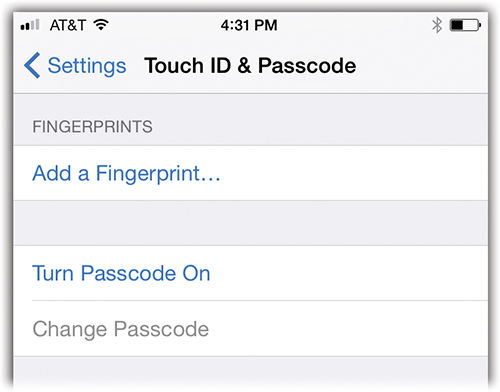
Tap Turn Passcode On. iOS proposes that you make up a six-digit passcode. But if you tap Passcode Options, you can choose instead a Custom Alphanumeric Code (any password, any length), Custom Numeric Code (an all-number code, any length), or 4-Digit Numeric Code (you know—ATM style).
You’re asked to type the passcode you want twice, to make sure you didn’t make a typo.
NOTE
Don’t kid around with this passcode. If you forget the iPhone code, you’ll have to restore your iPhone (???), which wipes out everything on it. You’ve probably still got most of the data on your computer or backed up on iCloud, of course (music, video, contacts, calendar), but you may lose text messages, mail, and so on.
Once you confirm your passcode, you return to the Passcode Lock screen. Here you have a few more options.
The Require Passcode option lets you specify how quickly the passcode is requested before locking somebody out: immediately after the iPhone wakes or 1, 15, 30, 60, or 240 minutes later. (Those options are a convenience to you, so you can quickly check your calendar or missed messages without having to enter the passcode—while still protecting your data from, for example, criminals who pick up your iPhone while you’re out getting coffee.)
Certain features are accessible on the Lock screen even before you’ve entered your passcode: the Today and Notifications tabs of the Notification Center; the Control Center; Siri, Wallet, Home Control, Reply with Message (the ability to reply to text messages right from their notification bubble on the Lock screen), and Return Missed Calls (the option to return a missed call from its bubble, without unlocking the phone; that’s new in iOS 11).
These are huge conveniences, but also, technically, a security risk. Somebody who finds your phone on your desk could, for example, blindly voice-dial your colleagues or use Siri to send a text. If you turn these switches off, then nobody can use these features until after unlocking the phone with your passcode, fingerprint, or face.
Finally, here is Erase Data—an option that’s scary and reassuring at the same time. When this option is on, if someone makes 10 incorrect guesses at your passcode, your iPhone erases itself. It’s assuming that some lowlife burglar is trying to crack into it to have a look at all your personal data.
This option, a pertinent one for professional people, provides potent protection from patient password prospectors.
And that is all. From now on, each time you wake your iPhone (if it’s not within the window of repeat visits you established), you’re asked for your passcode.
Fingerprint Security (Touch ID)
Most iOS 11 phones offer the option of using a more secure and convenient kind of “passcode”: your fingertip. (The exceptions are the iPhone 5c, which has no biometric features, and the iPhone X, which uses face recognition instead.)
The lens built right into the home button (clever!) reads your finger at any angle. It can’t be faked out by a plastic finger or even a chopped-off finger. You can teach it to recognize up to five fingerprints; they can all be yours, or some can belong to other people you trust.
Before you can use your fingertip as a passcode, though, you have to teach the phone to recognize it. Here’s how that goes:
Create a passcode. You can’t use a fingerprint instead of a passcode, only in addition to one. You’ll still need a passcode from time to time to keep the phone’s security tight. For example, you need to enter your passcode if you can’t make your fingerprint work (maybe it got encased in acrylic in a hideous crafts accident), or if you restart the phone, or if you haven’t used the phone in 48 hours or more.
So open Settings → Touch ID & Passcode and create a password, as already described.
Teach a fingerprint. At the top of the Touch ID & Passcode screen, you see the on/off switches for the three things your fingerprint can do: unlock the phone (iPhone Unlock), pay for things (Apple Pay), and serve as your password when you buy books, music, apps, and videos from Apple’s online stores (iTunes & App Store).
But what you really want to tap here, of course, is Add a Fingerprint.
Now comes the cool part. Place the finger you want to train onto the home button—your thumb or index finger are the most logical candidates. You’re asked to touch it to the home button over and over, maybe six times. Each time, the gray lines of the onscreen fingerprint darken a little more.
Once you’ve filled in the fingerprint, you see the Adjust Your Grip screen. Tap Continue. Now, the iPhone wants you to touch the home button another few times, this time tipping the finger a little each time so the sensor gets a better view of your finger’s edges.
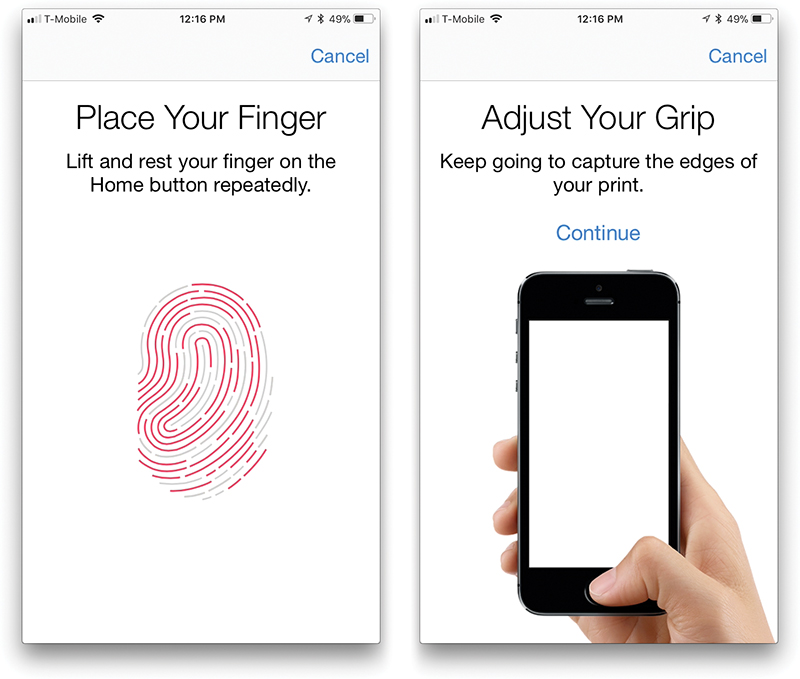
Once that’s done, the screen says “Success!”
You’re now ready to start using the fingerprint. Try it: Put the phone to sleep. Then wake it by pressing the home button, and leave your finger on the button for about a second. The phone reads your fingerprint and instantly unlocks itself.
And now, a few notes about using your fingerprint as a password:
Yes, you can touch your finger to the home button at the Lock screen. But you can also touch it at any Enter Passcode screen.
Suppose, for example, that your Lock screen shows that you missed a text message. And you want to reply. Well, you can swipe across that notification to open it in its native habitat—the Messages app—but first you’re shown the Enter Passcode screen. Ignore that. Just touch the home button with the finger whose print you recorded.
Apple says the image of your fingerprint is encrypted and stored in the iPhone’s processor chip. It’s never transmitted anywhere, it never goes online, and it’s never collected by Apple.
If you return to the Touch ID & Passcode screens, you can tap Add a Fingerprint again to teach your phone to recognize a second finger. And a third, fourth, and fifth.
On the other hand, it makes a lot of sense to register the same finger several times. You’ll be amazed at how much faster and more reliably your thumb (for example) is recognized if you’ve trained it as several different “fingerprints.”
To rename a fingerprint, tap its current name (“Finger 1” or whatever). To delete one, tap its name and then tap Delete Fingerprint. (You can figure out which finger label is which by touching the home button; the corresponding label blinks. Sweet!)
You can register your toes instead of fingers, if that’s helpful. Or even patches of your wrist or arm, if you’re patient (and weird).
The Touch ID scanner may have trouble recognizing your touch if your finger is wet, greasy, or scarred.
The iPhone’s finger reader isn’t just a camera; it doesn’t just look for the image of your fingerprint. It’s actually measuring the tiny differences in electrical conductivity between the raised parts of your fingerprint (which aren’t conductive) and the skin just beneath the surface (which is). That’s why a plastic finger won’t work—and even your own finger won’t work if it’s been chopped off (or if you’ve died).
Fingerprints for Apps, Websites, and Apple Pay
So if your fingerprint is such a great solution to password overload, how come it works only to unlock the phone and to buy stuff from Apple’s online stores? Wouldn’t it be great if your fingerprint could also log you into secure websites? Or serve as your ID when you buy stuff online?
That dream is finally becoming a reality. Software companies can now use your Touch ID fingerprint to log into their apps. Mint (for checking your personal finances), Evernote (for storing notes, pictures, and to-do lists), Amazon (for buying stuff), and other apps now permit you to substitute a fingerprint touch for typing a password.
What’s really wild is that password-storing apps like 1Password and LastPass have been updated, too. Those apps are designed to memorize your passwords for all sites on the web, of every type—and now you can use your fingerprint to unlock them.
Moreover, your fingerprint is now the key to the magical door of Apple Pay, the wireless pay-with-your-iPhone technology described in “Apple Pay”.
All of this is great news. Most of us would be happy if we never, ever had to type in another password.
Face ID (iPhone X)
When Apple decided to cover the entire face of the iPhone X with screen, there was an obvious problem: the home button. Were they really going to interrupt that gorgeous ocean of OLED screen with a cutout for the home button?
Nope. The home button went away. In place of its functions, Apple came up with the various swipes and side-button presses described in this book. And in place of the fingerprint reader, the iPhone X has a facial recognition system. Basically, you unlock the phone by looking at it.
You can’t fool Face ID with a photo, a mask, or even a 3D model of your head. It works in the dark. It works if you change hairstyles, glasses, makeup, or facial hair. It works through most sunglasses. It works if you’re wearing a hat and scarf (it just has to see your eyes, nose, and mouth).
If you grow fat, or skinny, or old, it will still work, because it gradually updates its model of your face as you use it. (And if you have radical plastic surgery, well, you’ll have to retrain it. Takes about a minute.)
It can’t be forced on you when you’re sleeping, because you have to be looking at the phone. It can’t be forced on you by a police officer, because you can disable it with a quick, secret button press (“Help from the Shutdown Screen”).
Whereas one in 50,000 people might be able to get into your phone with a fingerprint, Face ID’s miss rate is one in a million. (The exception: Your identical twin might be able to fool Face ID. You’ve been warned.)
You’ll use Face ID wherever you used to use your fingerprint: triggering Apple Pay, for example, or logging into apps like Mint, 1Password, and E-Trade.
TrueDepth
So how does the phone recognize your face? Using a mass of sensors Apple calls TrueDepth. They’re hiding in the Notch at the top of the iPhone X.
When you wake the phone, an infrared lamp (called the flood illuminator—but you knew that) blasts invisible light forward to see if a face is in range. If so, a tiny dot projector blasts 30,000 pinpoints of infrared light onto your face, and an infrared camera reads the distortion of their spacing and shape to find its contours. (That’s why Face ID works in the dark—it relies on infrared light.)
If the infrared camera confirms that you’re you—if the mathematical model of your facial contours matches what it captured when you trained it—then the phone unlocks. Only the tiny opening of a padlock on the Lock screen signifies that facial recognition has done its thing.
Training Face ID
In most ways, Face ID works exactly like Touch ID, described earlier. For example, you must create a passcode as a backup before you can turn on Face ID.
You’ll need that passcode from time to time, for added security—after you’ve restarted the phone, after five failed attempts to log in with facial recognition, and so on (see “Closing the Control Center”).
After creating your passcode in Settings → Face ID & Passcode, tap Set Up Face ID. Center your face in the circle, and then trace a circle in the air with your nose, so that the frame of your face circle fills in. You’re asked to do this a second time—and that’s all it needs to create its model of your face.
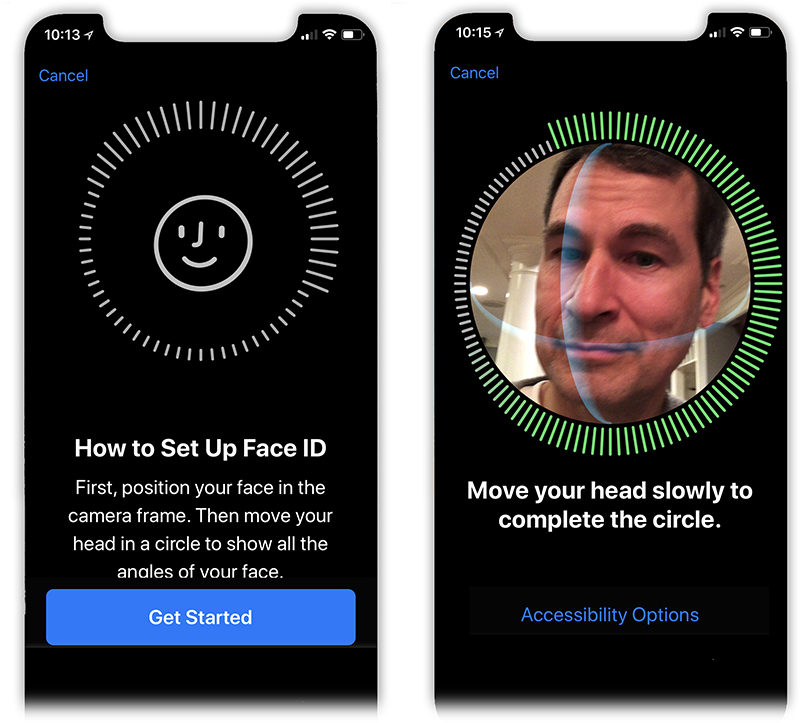
(Apple stresses that the scan of your face is never transmitted, not even to Apple, and not part of any backup. It’s stored in a protected piece of memory called the Secure Enclave.)
Using Face ID
From now on, you can unlock your iPhone X like this:
Wake the phone by tapping the screen, pressing the side button, or tipping the phone upright.
Look at the phone. A white padlock at the top of the screen opens to show you that Face ID has recognized you and unlocked the phone.
If all you wanted to do was check your notifications or something, that’s all there is to it. In fact, what’s especially cool is that when you wake the phone, message and mail notifications don’t reveal their contents (below, left)—but once the phone recognizes you, they expand in place (right)!
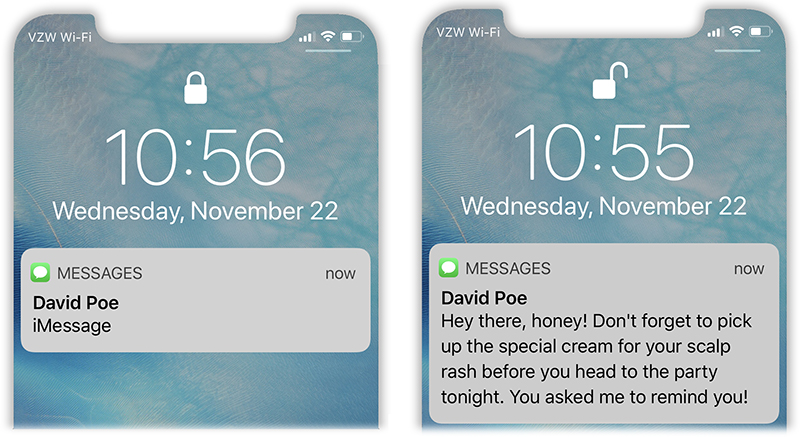
If you actually want to proceed—to go to the Home screen, for example—then there’s one more step:
Swipe up from beneath the screen. It can be a short, quick swipe. The Home screen (or whatever app you were using) appears. You’re in.
Every now and then, Face ID doesn’t unlock when you look at it, and asks that you enter your passcode. Do so! Each time, Face ID learns from its mistake and is more likely to recognize you the next time.
TIP
There are some useful options to change in Face ID: See “Meet Haptics”.
Get iPhone: The Missing Manual, 11th Edition now with the O’Reilly learning platform.
O’Reilly members experience books, live events, courses curated by job role, and more from O’Reilly and nearly 200 top publishers.

